Africa is home to a stunning variety of languages, each reflecting the continent’s rich history and cultural depth. Among the top 35 most spoken languages, such as Swahili, Arabic, Yoruba, and Zulu, we see a snapshot of Africa’s complex social and historical landscape. These languages do more than just facilitate daily communication; they play a crucial role in shaping cultural identities.
Every language has its own structure and vocabulary, acting as a living record of Africa’s past and its ongoing changes. By exploring these languages, we learn about their importance to community bonds and cultural continuity.
Top 35 Most Spoken Languages
Diving into the most spoken languages in Africa, we find a vast array of languages that show just how diverse the continent is. Swahili leads the way in East Africa with over 100 million people speaking it. It’s like a bridge that connects different cultures there.
Arabic
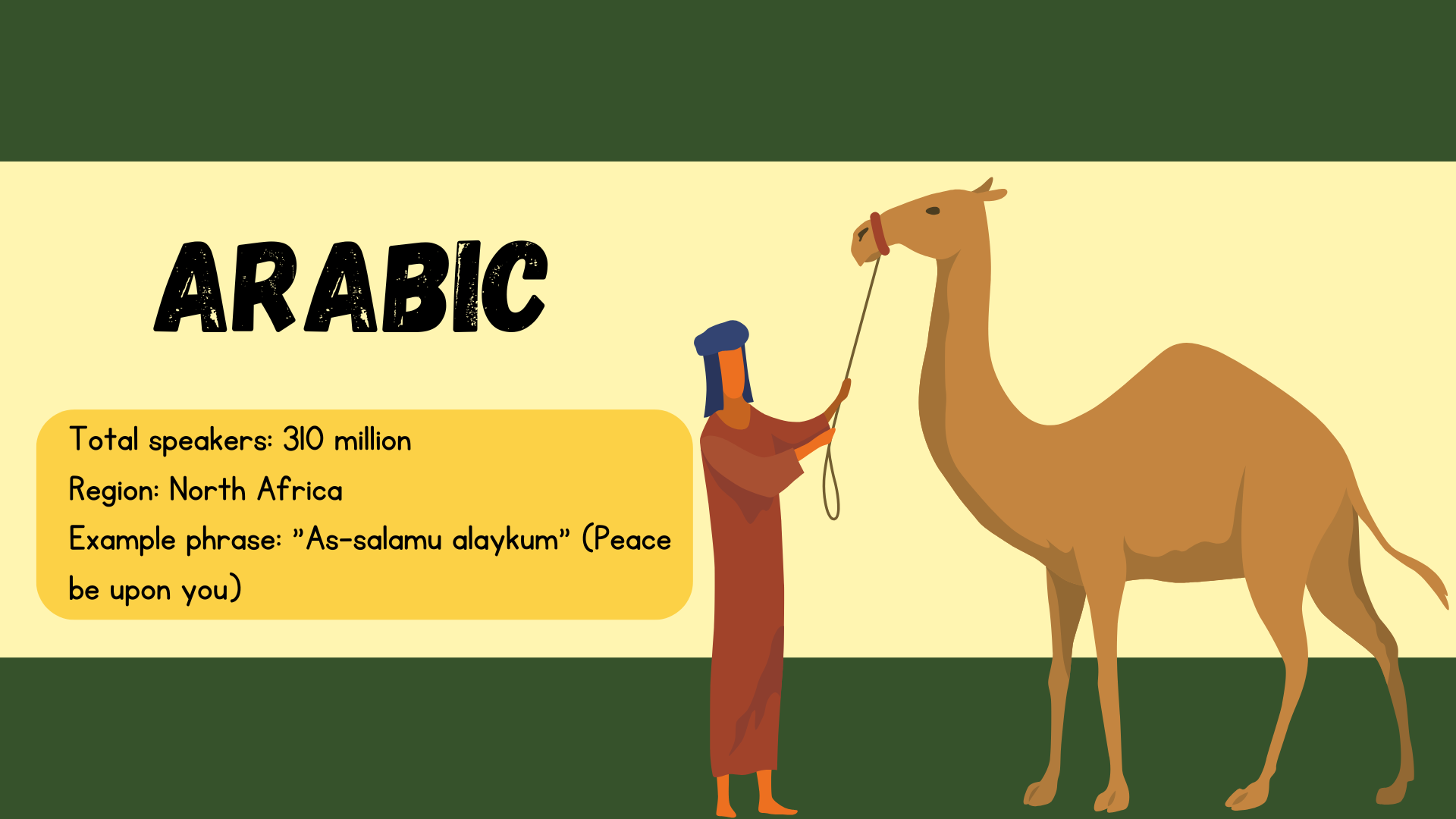
- Total speakers: 310 million
- Region: North Africa
- Example phrase: “As-salamu alaykum” (Peace be upon you)
Arabic is the most widely spoken language in Africa, mainly in the northern regions. It has deep historical roots in the spread of Islam, which brought the language across the continent. As the official language of many North African countries, it has various dialects, with Modern Standard Arabic being the formal variant used in education and government. Arabic’s influence extends to literature, philosophy, and religious texts across centuries.
Swahili
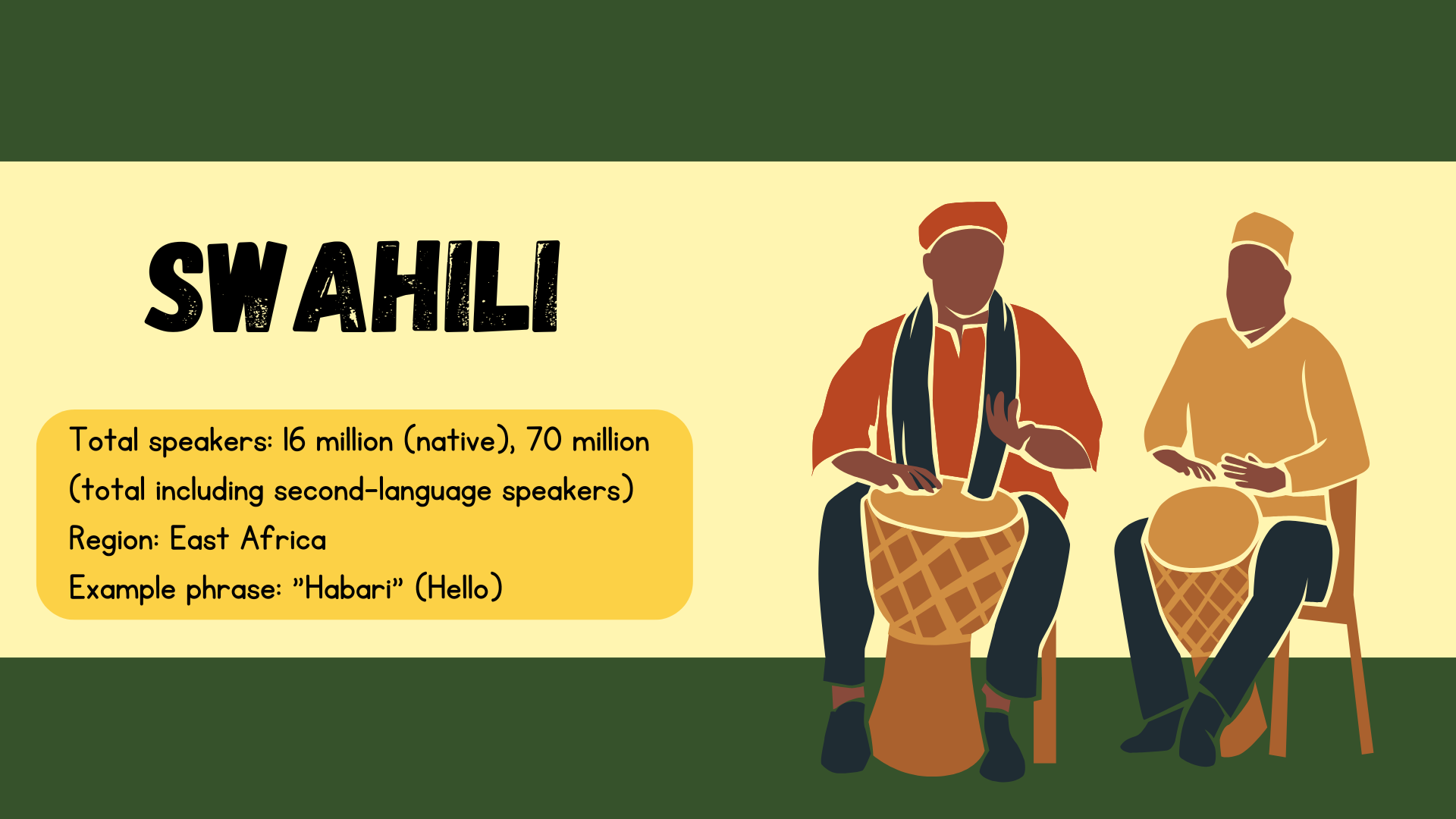
- Total speakers: 16 million (native), 70 million (total including second-language speakers)
- Region: East Africa
- Example phrase: “Habari” (Hello)
Swahili, or Kiswahili, is a widely spoken Bantu language used in East Africa. It developed as a trade language along the coast, blending Bantu roots with Arabic influences due to the long history of trade with Arab merchants. Swahili is the official language of Kenya, Tanzania, and Uganda and serves as a lingua franca in many other East African countries. It is also an official language of the African Union.
Hausa
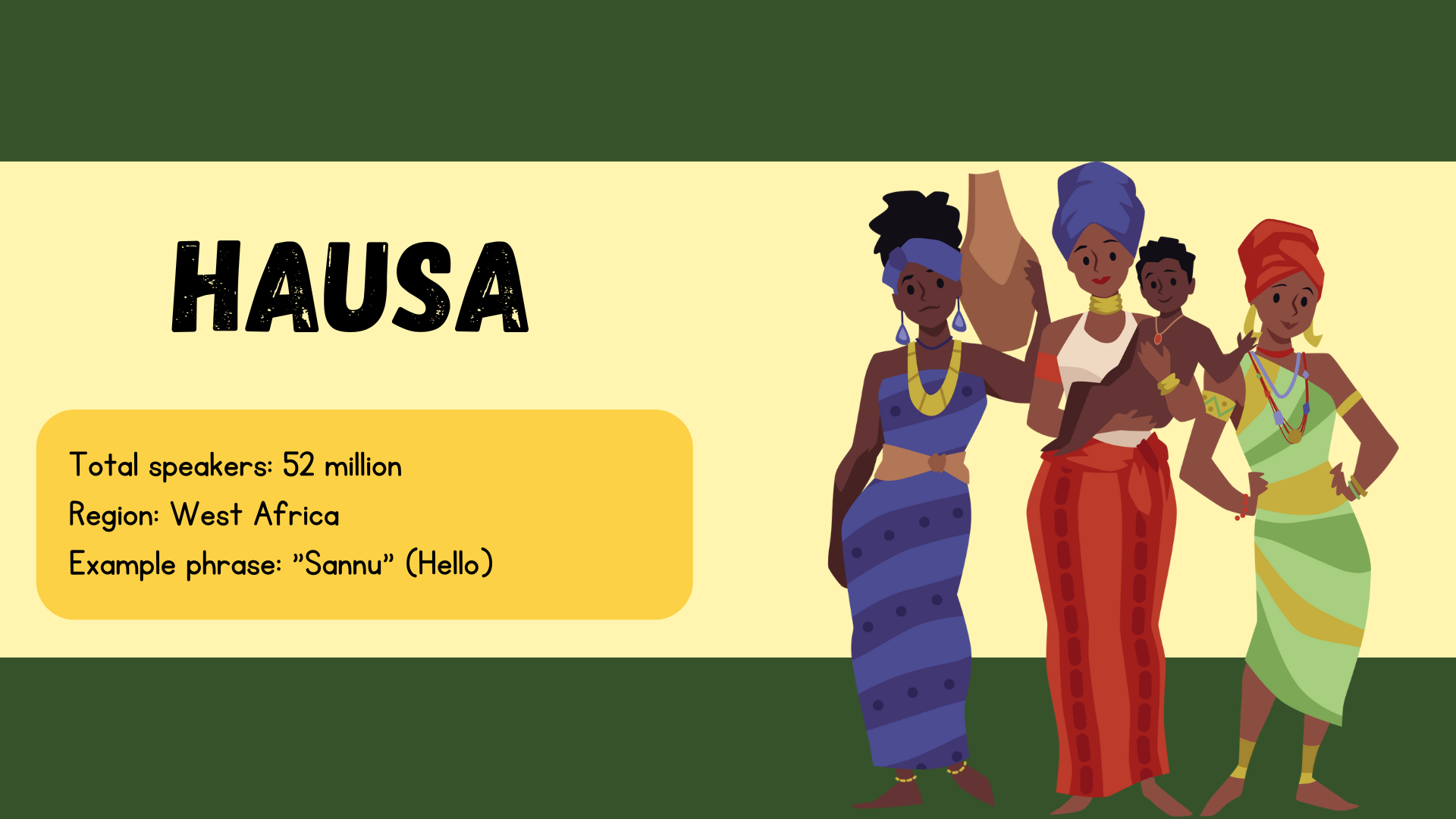
- Total speakers: 52 million
- Region: West Africa
- Example phrase: “Sannu” (Hello)
Hausa is one of the largest and most important languages in West Africa, especially spoken in Nigeria and Niger. As a Chadic language, it has spread through trade and Islamic influence across the region. Hausa is a lingua franca in much of West Africa and is used for broadcasting and in educational settings. Its rich tradition includes proverbs, oral literature, and music, making it a cornerstone of West African culture.
Yoruba
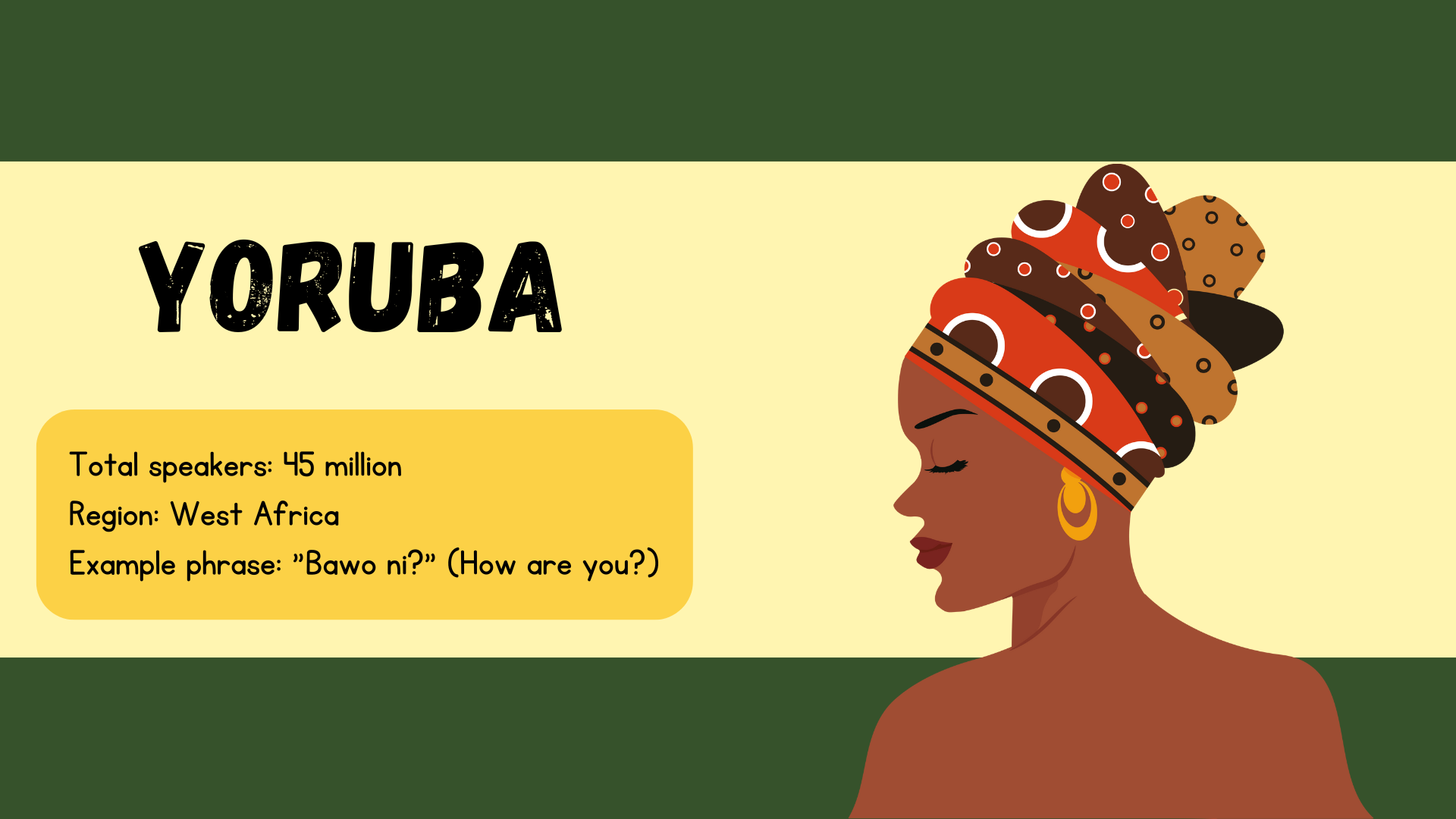
- Total speakers: 45 million
- Region: West Africa
- Example phrase: “Bawo ni?” (How are you?)
Yoruba is a Niger-Congo language predominantly spoken in Nigeria, Benin, and Togo. It has a rich cultural and religious history, with influences from African traditional religions, Christianity, and Islam. Yoruba literature is deeply tied to oral traditions, with proverbs and folklore playing a key role. The language’s widespread use in the diaspora, particularly in the Americas, is tied to the Transatlantic Slave Trade.
Amharic
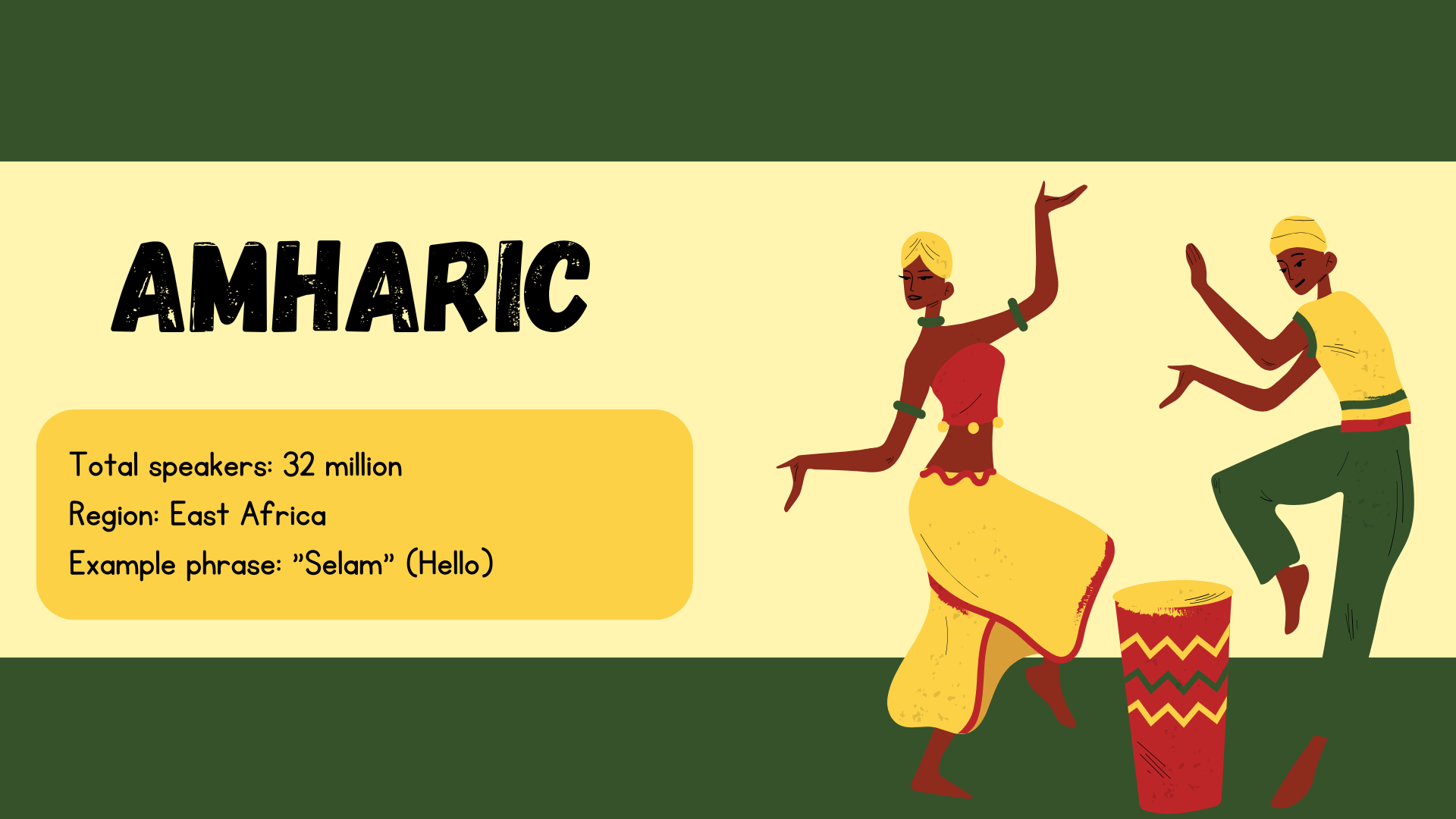
- Total speakers: 32 million
- Region: East Africa
- Example phrase: “Selam” (Hello)
Amharic is the official language of Ethiopia and one of the most important Semitic languages in Africa. It is the second-most spoken Semitic language in the world after Arabic. Amharic’s script, Ge’ez, is one of the few indigenous alpha syllabaries in the world. The language is a symbol of Ethiopian identity, and its literary history is linked to ancient religious texts and Ethiopia’s unique Christian traditions.
Oromo
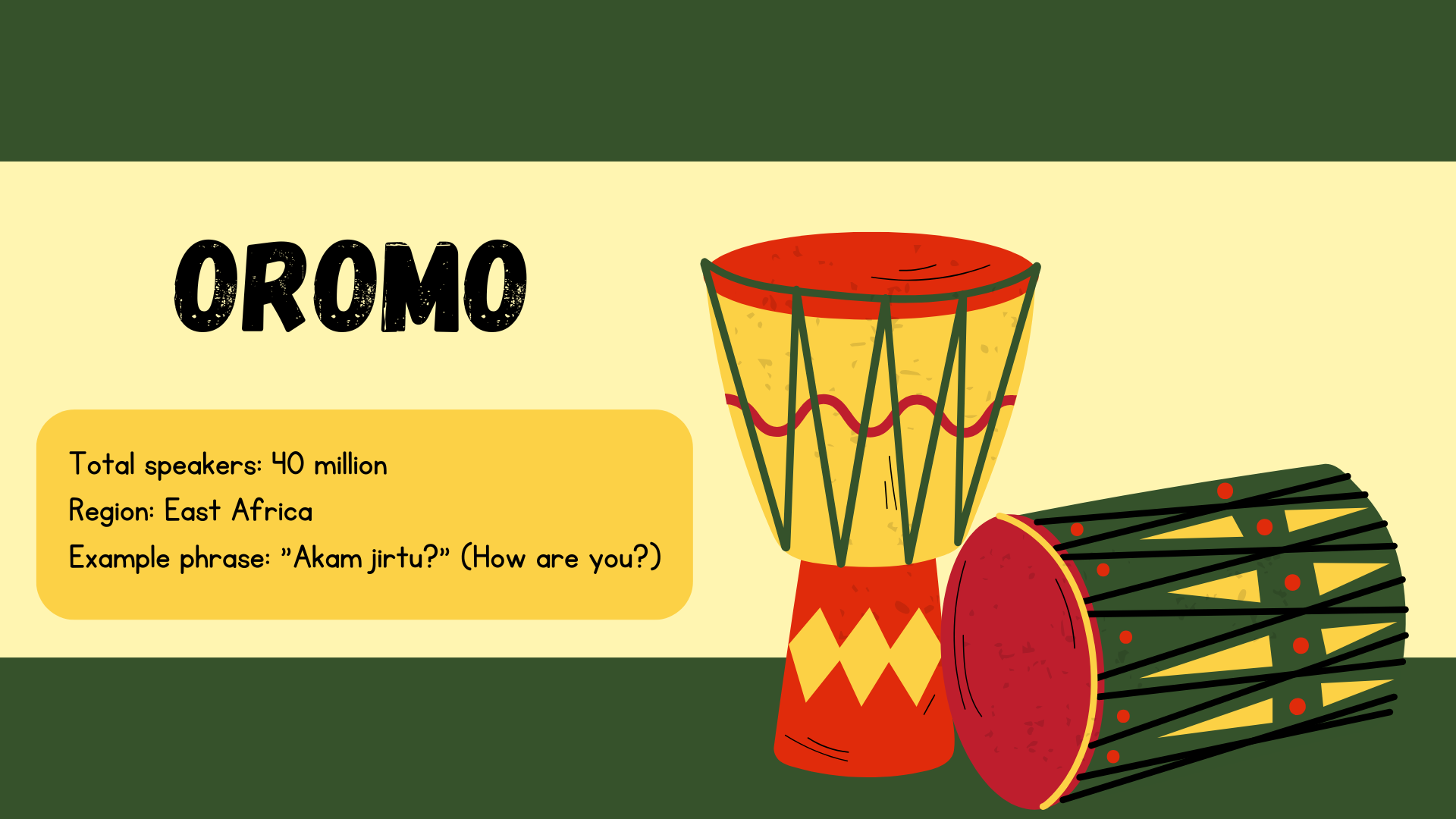
- Total speakers: 40 million
- Region: East Africa
- Example phrase: “Akam jirtu?” (How are you?)
Oromo is a Cushitic language spoken primarily in Ethiopia and parts of Kenya. It is the most spoken Afroasiatic language in the Horn of Africa. Oromo has a rich oral tradition and is also written using the Latin alphabet. It is the primary language of the Oromo people, one of the largest ethnic groups in Africa. The language has a history of resistance and resilience, especially in Ethiopia, where it has recently gained prominence.
Igbo
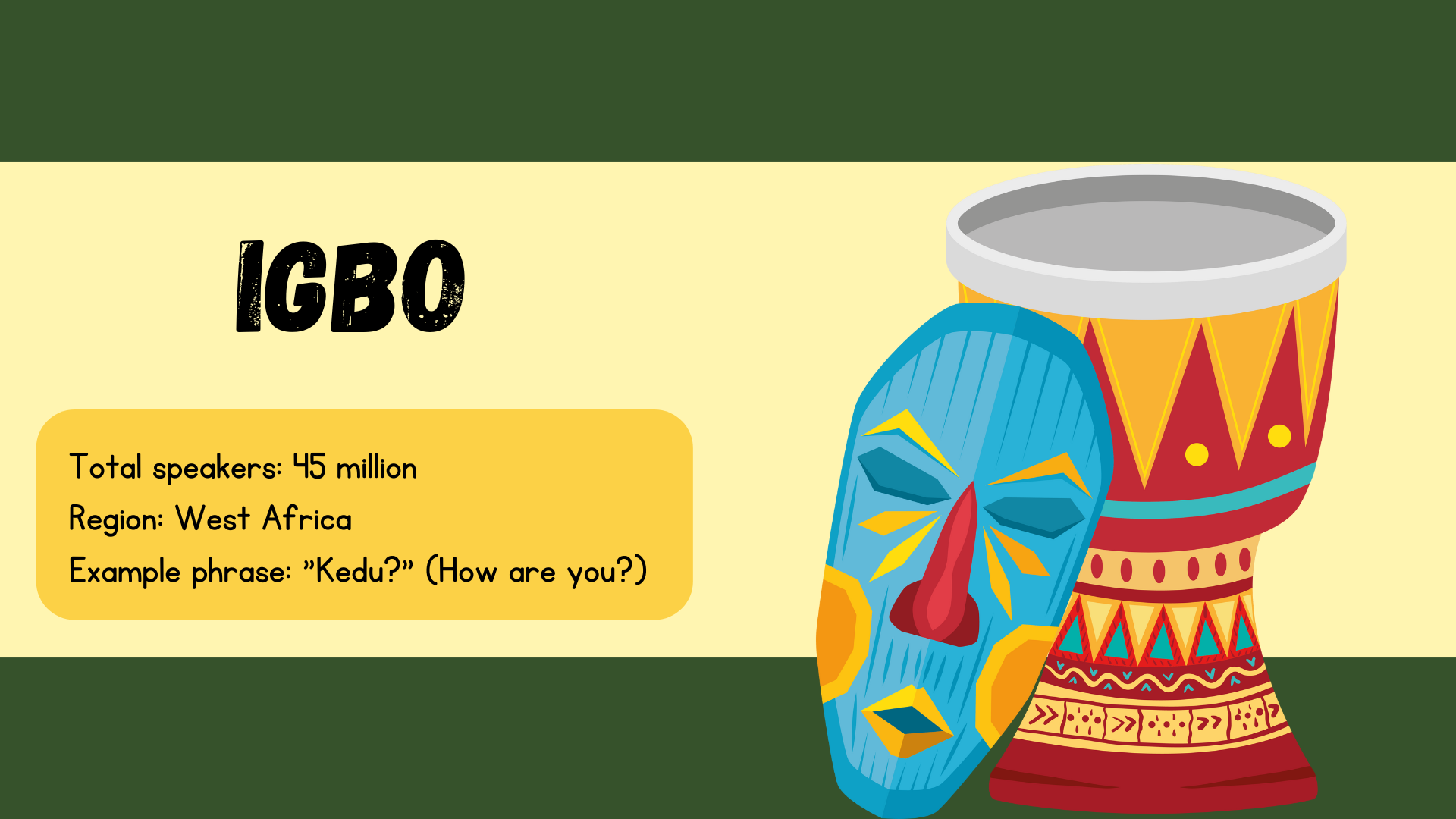
- Total speakers: 45 million
- Region: West Africa
- Example phrase: “Kedu?” (How are you?)
Igbo is a major language of southeastern Nigeria, with millions of speakers in neighboring countries. As part of the Niger-Congo family, it has many dialects, which vary greatly across regions. Igbo is known for its rich oral traditions, including storytelling, proverbs, and songs. Despite historical challenges, including the effects of the Nigerian Civil War, Igbo remains an essential cultural pillar for its speakers.
Zulu
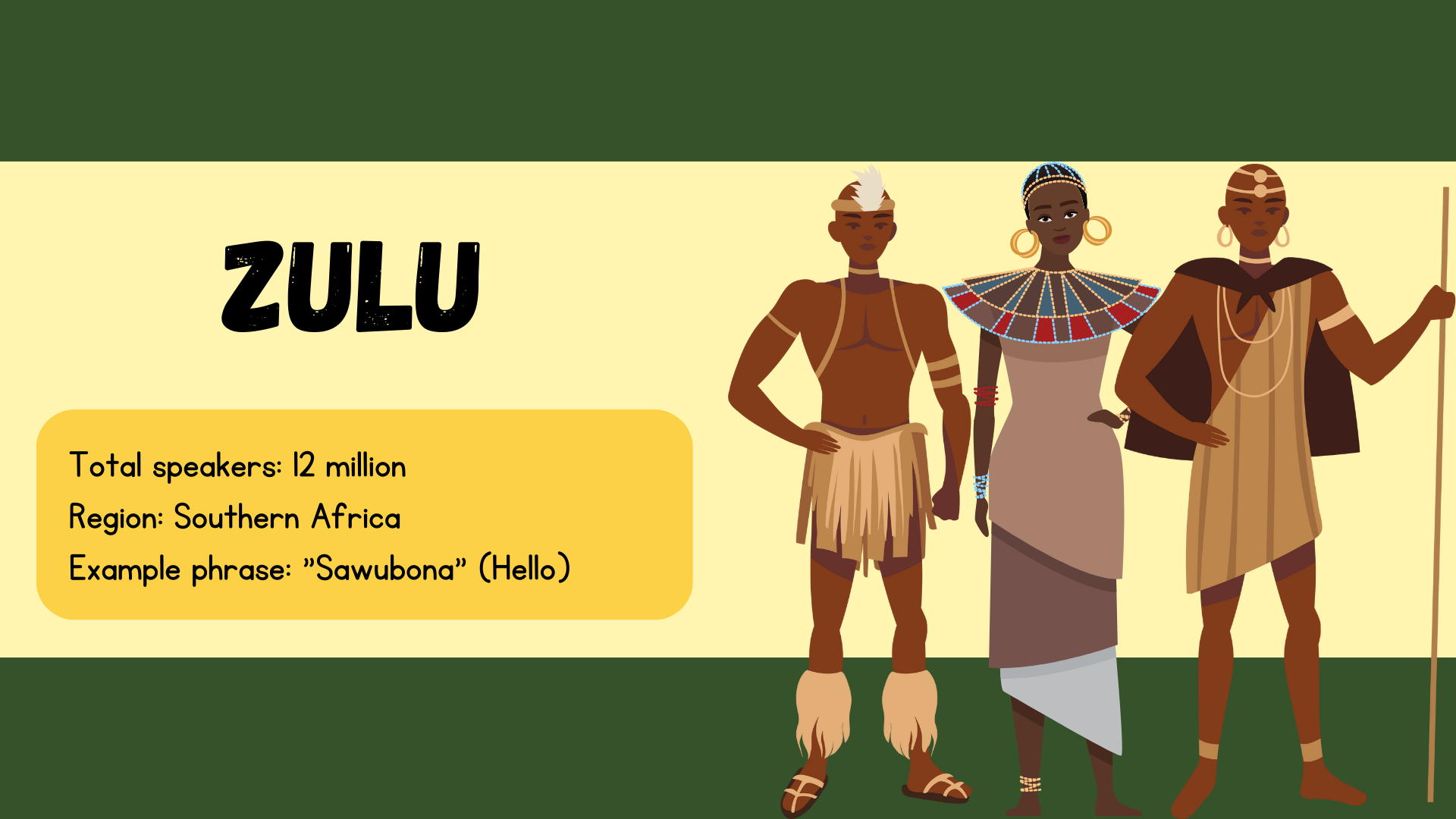
- Total speakers: 12 million
- Region: Southern Africa
- Example phrase: “Sawubona” (Hello)
Zulu, one of South Africa’s 11 official languages, is a Bantu language spoken by the Zulu people in Southern Africa. It is widely known for its use of clicks, a feature inherited from its Khoisan neighbors. Zulu has a rich tradition of oral literature, including epic poems, songs, and folk tales. The Zulu nation has had a significant impact on South African history and culture, and the language remains a symbol of pride for millions
Shona
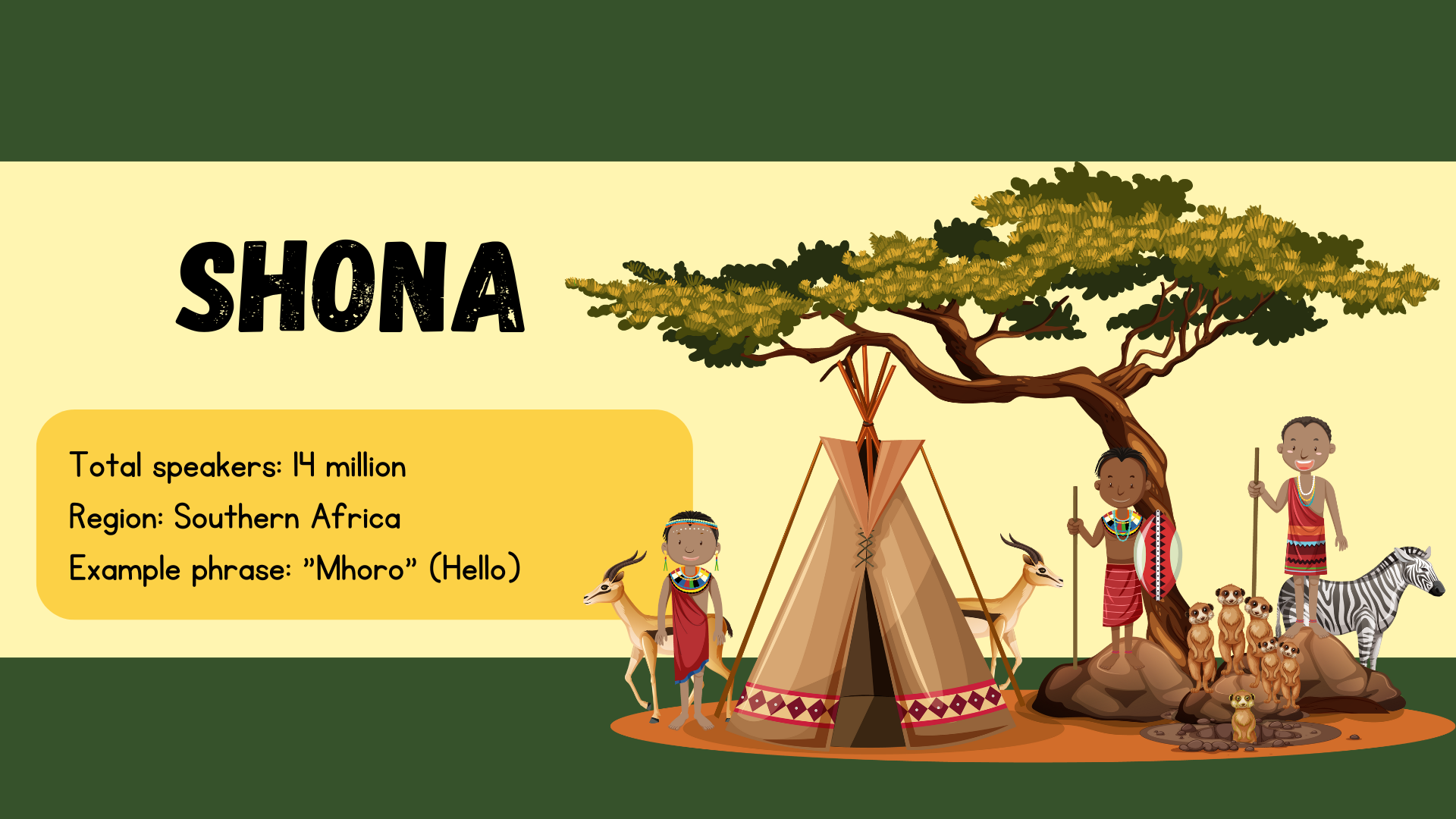
- Total speakers: 14 million
- Region: Southern Africa
- Example phrase: “Mhoro” (Hello)
Shona is the principal language spoken in Zimbabwe and parts of Mozambique. It belongs to the Bantu group of languages and is known for its musicality and tonal quality. Shona has a rich history tied to the Great Zimbabwe civilization, whose archaeological remnants are considered a national treasure. The language is used in daily life, and media, and is a symbol of national identity for Zimbabweans.
French
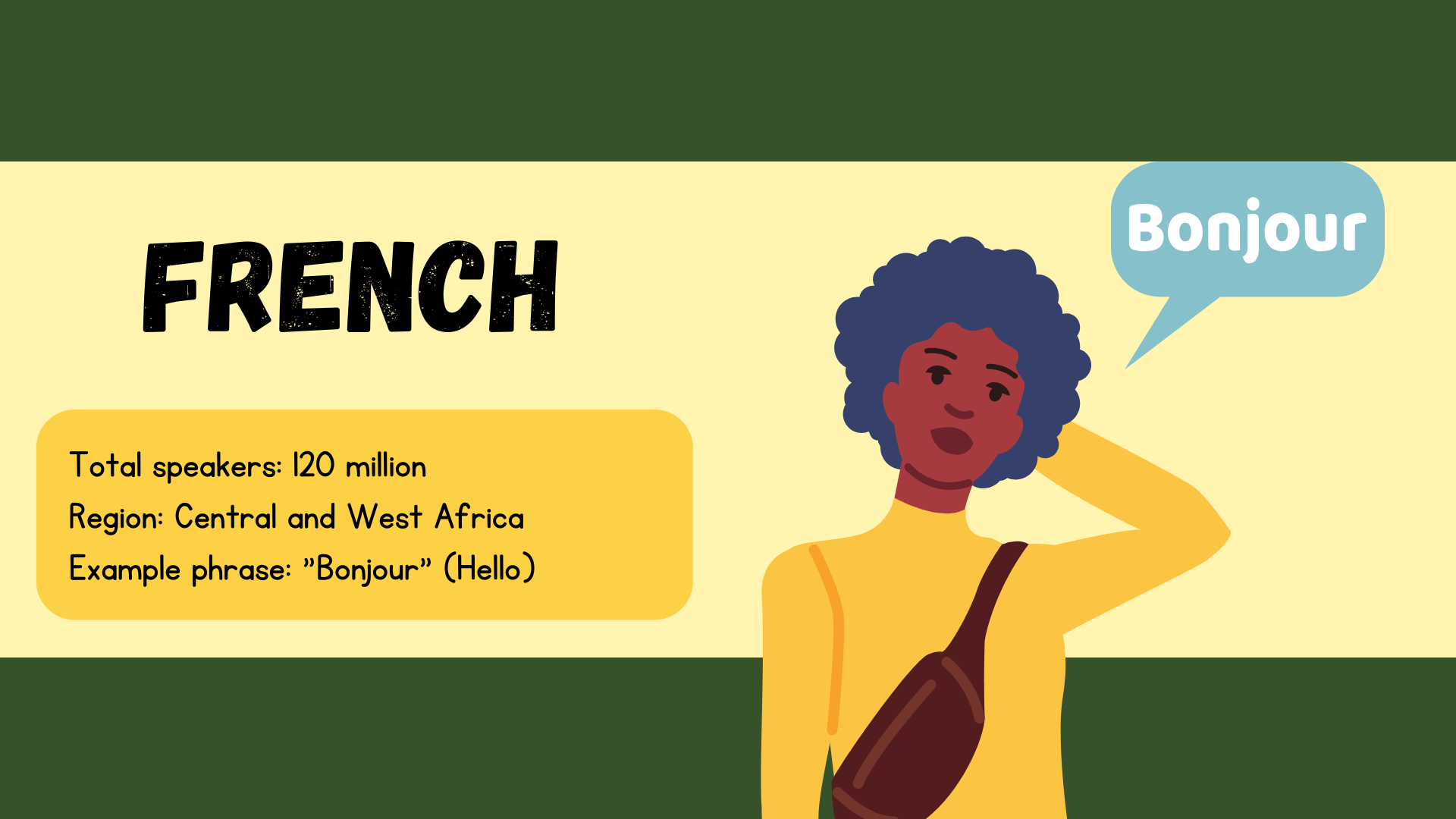
- Total speakers: 120 million
- Region: Central and West Africa
- Example phrase: “Bonjour” (Hello)
French, a legacy of colonialism, is one of Africa’s most widely spoken languages, especially in West and Central Africa. It is an official language in many countries such as the Democratic Republic of the Congo, Ivory Coast, and Senegal. The French language is used in government, education, and media, and its influence permeates the culture, arts, and literature of these regions. Its widespread use across the continent highlights the enduring effects of European colonial rule.
Berber
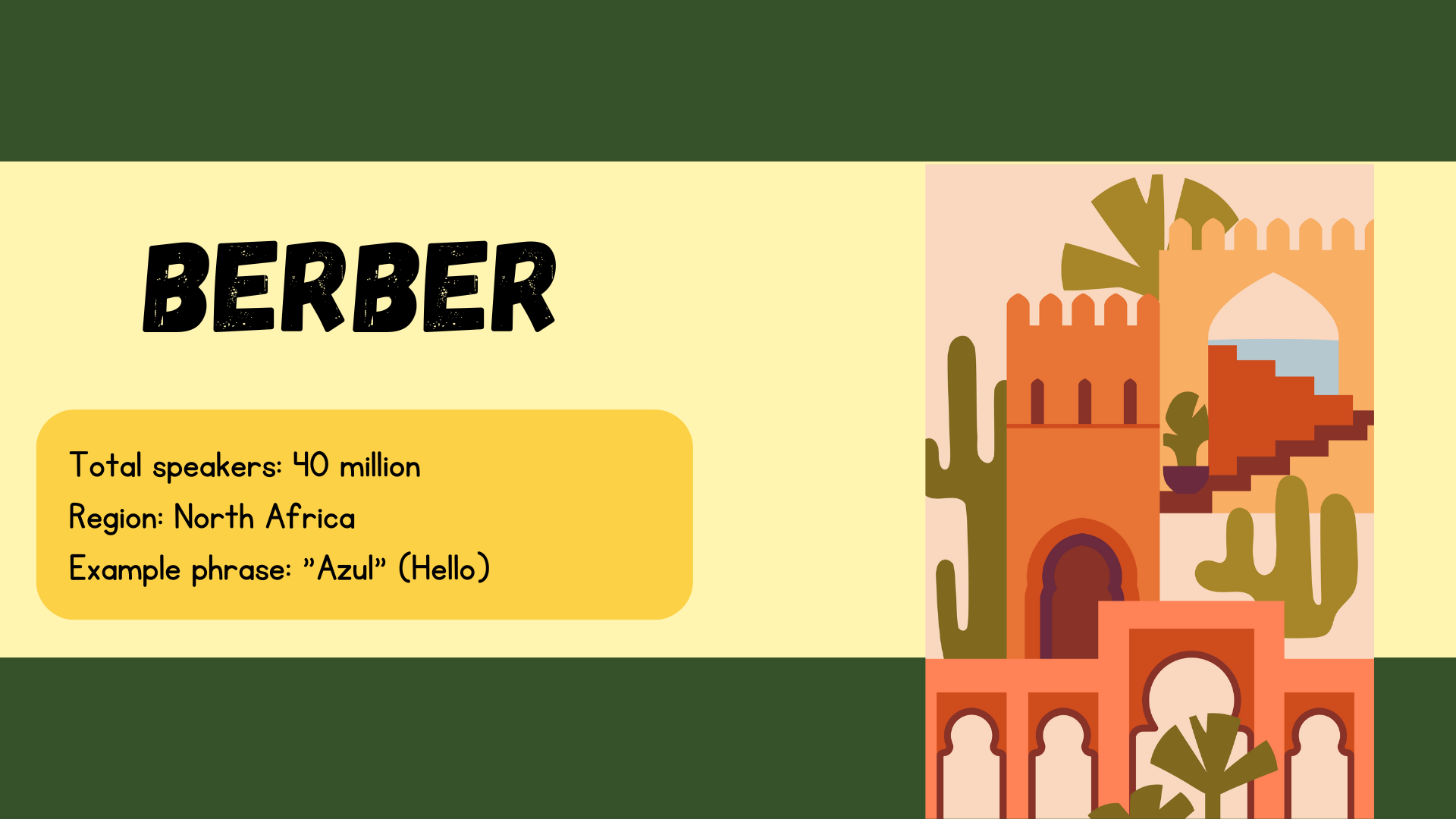
- Total speakers: 40 million
- Region: North Africa
- Example phrase: “Azul” (Hello)
Berber languages, or Tamazight, belong to the Afroasiatic family and are spoken by the indigenous Berber people of North Africa. These languages have a rich historical legacy, dating back to ancient times, and continue to thrive in countries like Morocco, Algeria, and Libya. The Berber alphabet, Tifinagh, is one of the oldest writing systems in the world, and Berber speakers have a strong cultural identity tied to their language and traditions.
Portuguese
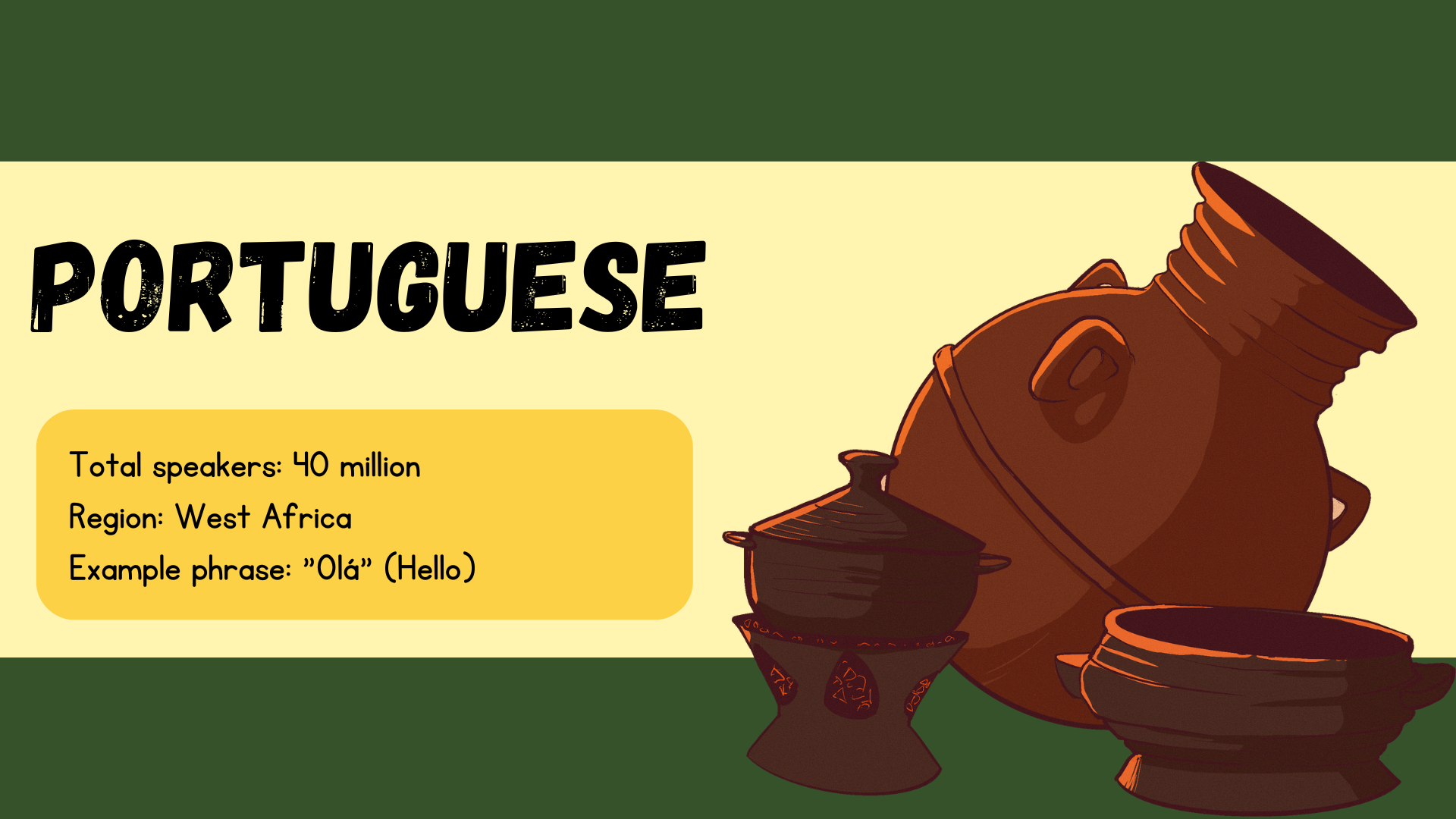
- Total speakers: 40 million
- Region: West Africa
- Example phrase: “Olá” (Hello)
Portuguese, another legacy of colonialism, is spoken mainly in Angola, Mozambique, and Guinea-Bissau. It serves as the official language of these countries and remains a key language of communication, education, and governance. Portuguese in Africa has developed its own unique characteristics, influenced by local languages, and continues to be a bridge language for diverse communities across the continent.
Somali
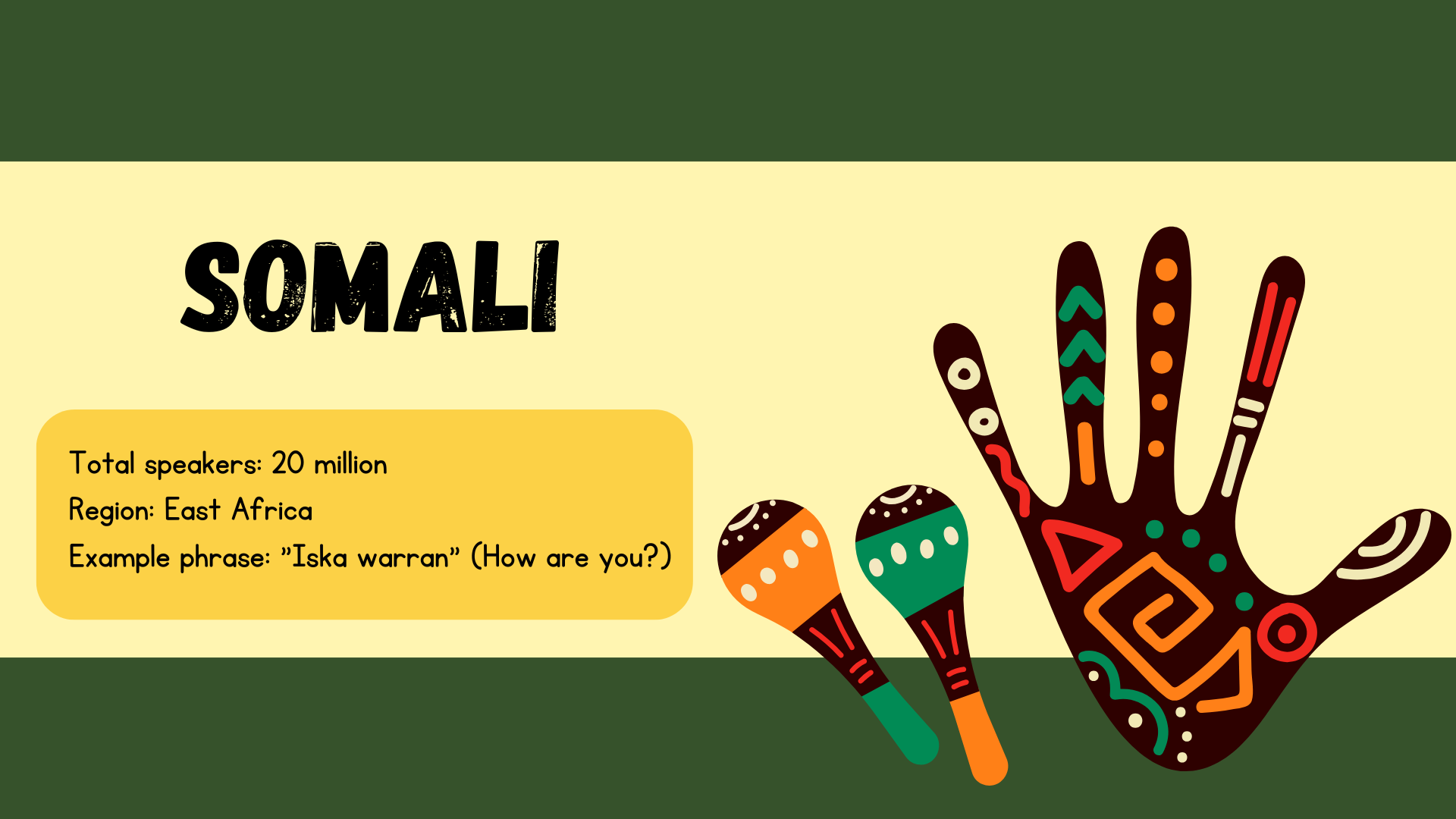
- Total speakers: 20 million
- Region: East Africa
- Example phrase: “Iska warran” (How are you?)
Somali is a Cushitic language spoken predominantly in Somalia, Djibouti, and parts of Ethiopia and Kenya. Somali is rich in oral tradition, with a long history of poetry, songs, and storytelling. The Somali language was officially standardized in 1972, and it was written using the Latin script. Somali has become a vital part of Somali identity and cultural pride, especially in the diaspora.
Tswana
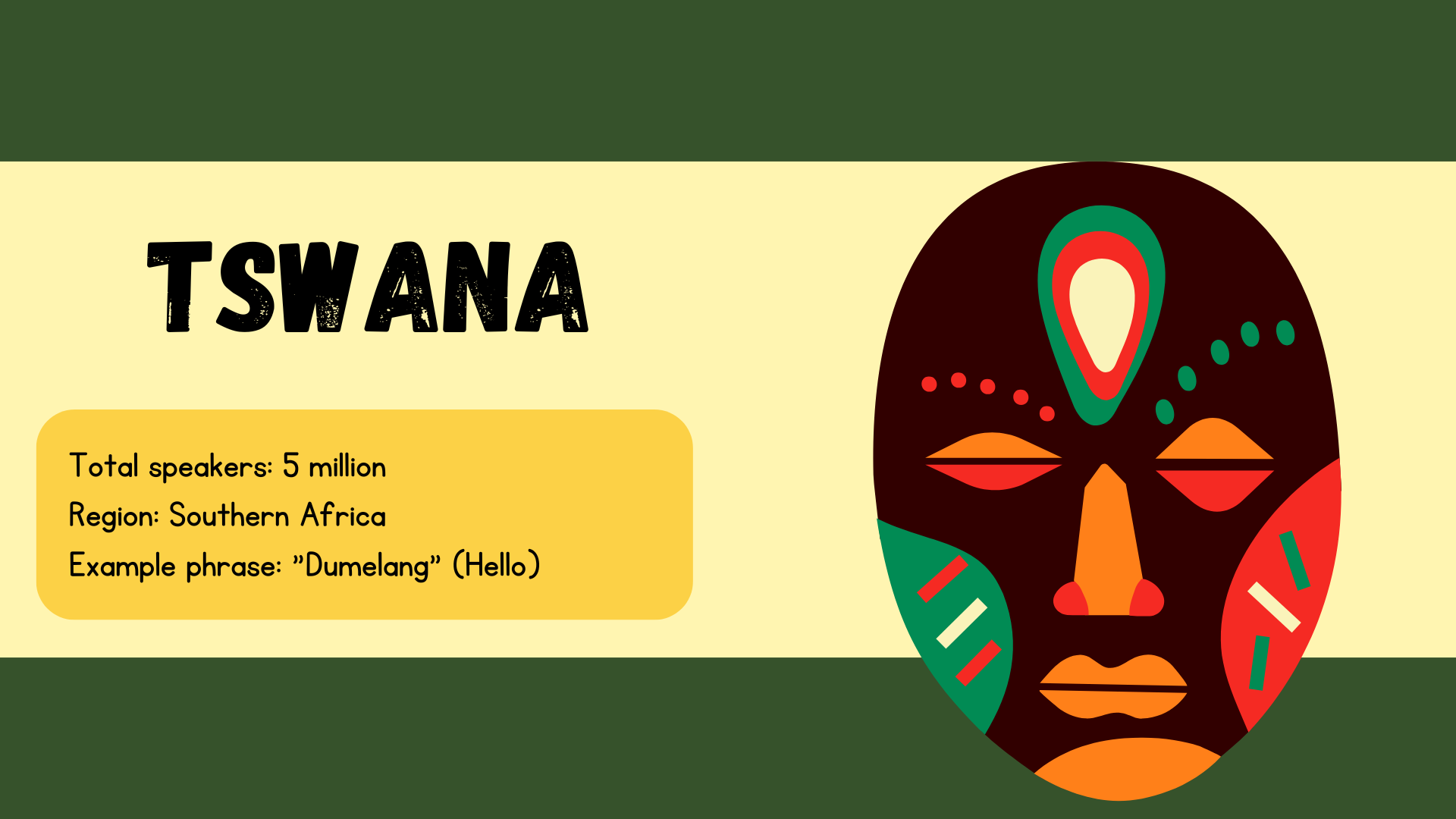
- Total speakers: 5 million
- Region: Southern Africa
- Example phrase: “Dumelang” (Hello)
Tswana, also known as Setswana, is spoken in Botswana and parts of South Africa, Namibia, and Zimbabwe. It is a Bantu language and has a rich tradition of oral literature, including folktales and proverbs. Tswana serves as one of the official languages of Botswana and is used in education, media, and government. The language plays a central role in the cultural and national identity of Botswana.
Kinyarwanda
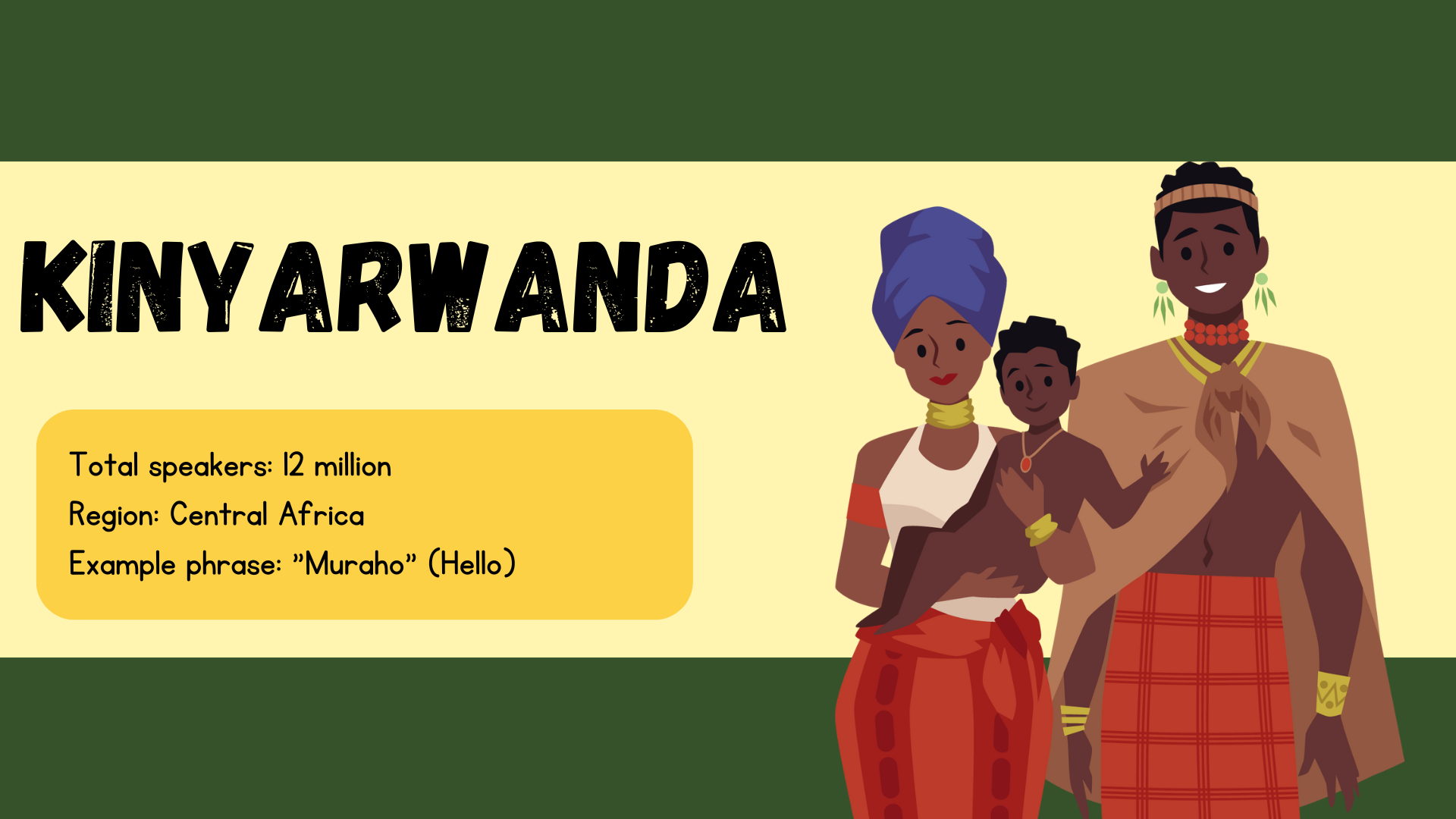
- Total speakers: 12 million
- Region: Central Africa
- Example phrase: “Muraho” (Hello)
Kinyarwanda is the official language of Rwanda and is spoken by over 12 million people. It belongs to the Bantu language family and is mutually intelligible with Kirundi, spoken in Burundi. Kinyarwanda has a deep connection to the culture and history of Rwanda, and its use in education, government, and media has played a central role in the post-genocide reconciliation and unity process.
Lingala
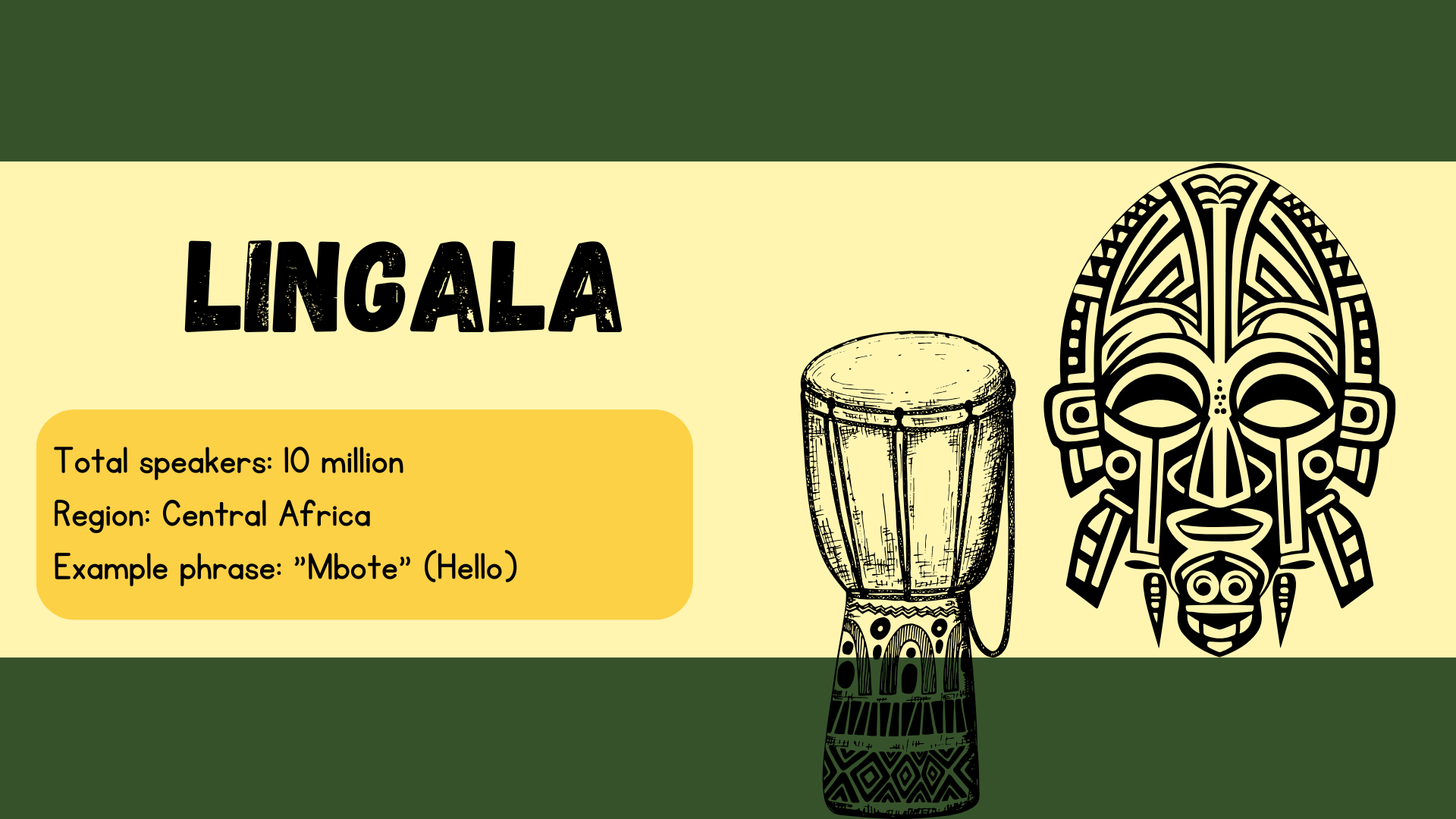
- Total speakers: 10 million
- Region: Central Africa
- Example phrase: “Mbote” (Hello)
Lingala is widely spoken in the Democratic Republic of the Congo and the Republic of the Congo. Originally a trade language, it has become the lingua franca of much of Central Africa. It is especially prominent in the music industry, with genres like soukous and rumba helping to popularize the language. Lingala is used in daily communication, as well as in government, media, and entertainment.
Tigrinya
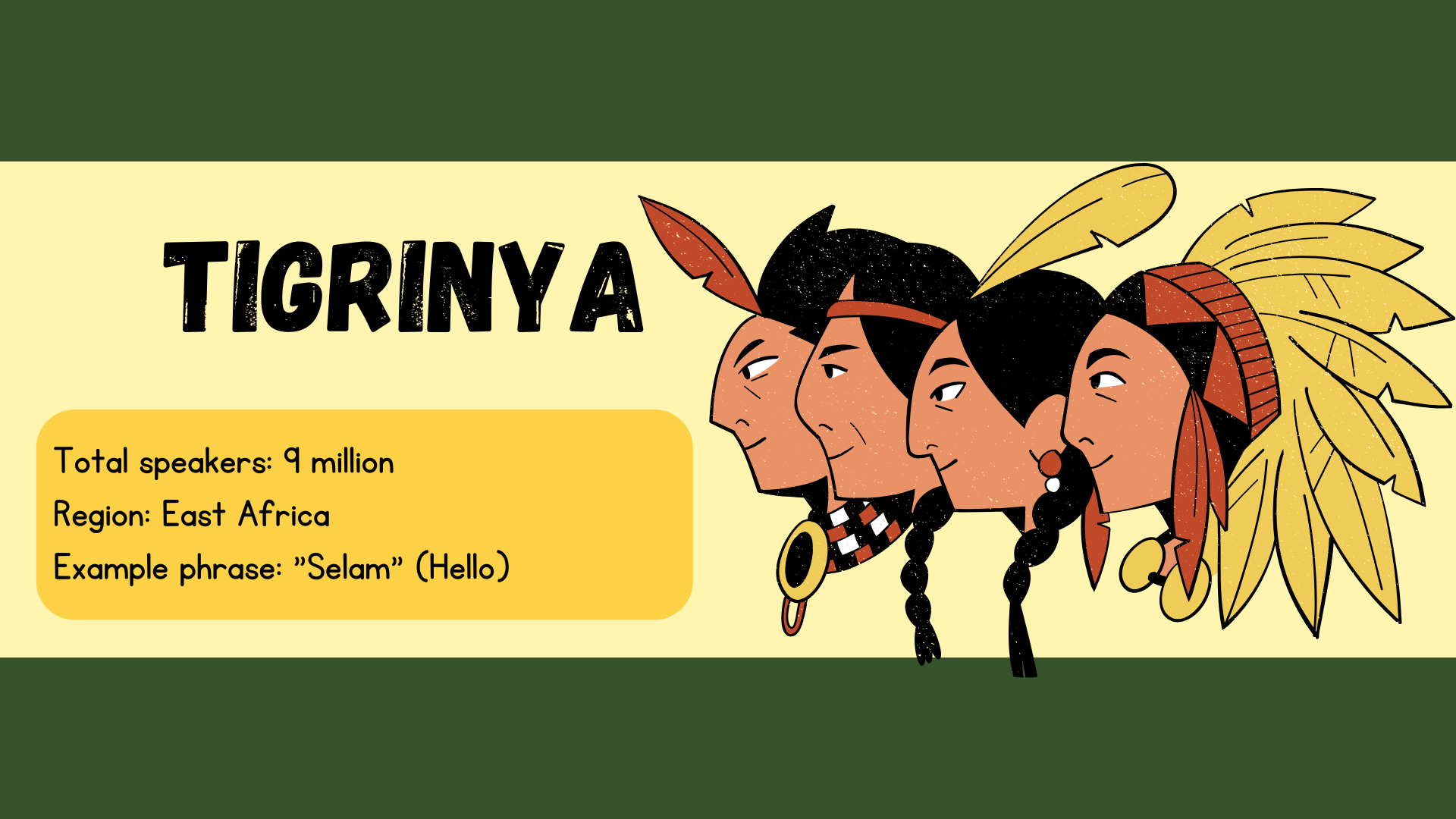
- Total speakers: 9 million
- Region: East Africa
- Example phrase: “Selam” (Hello)
Tigrinya is spoken in Eritrea and northern Ethiopia, primarily by the Tigrinya people. It is a Semitic language, and like Amharic, it uses the Ge’ez script. The language has historical significance in the region and is closely tied to the Ethiopian Orthodox Church. Tigrinya has an extensive oral literature tradition, and its usage in government and education makes it an important part of the cultural identity of the Eritrean and Tigray people.
Xhosa
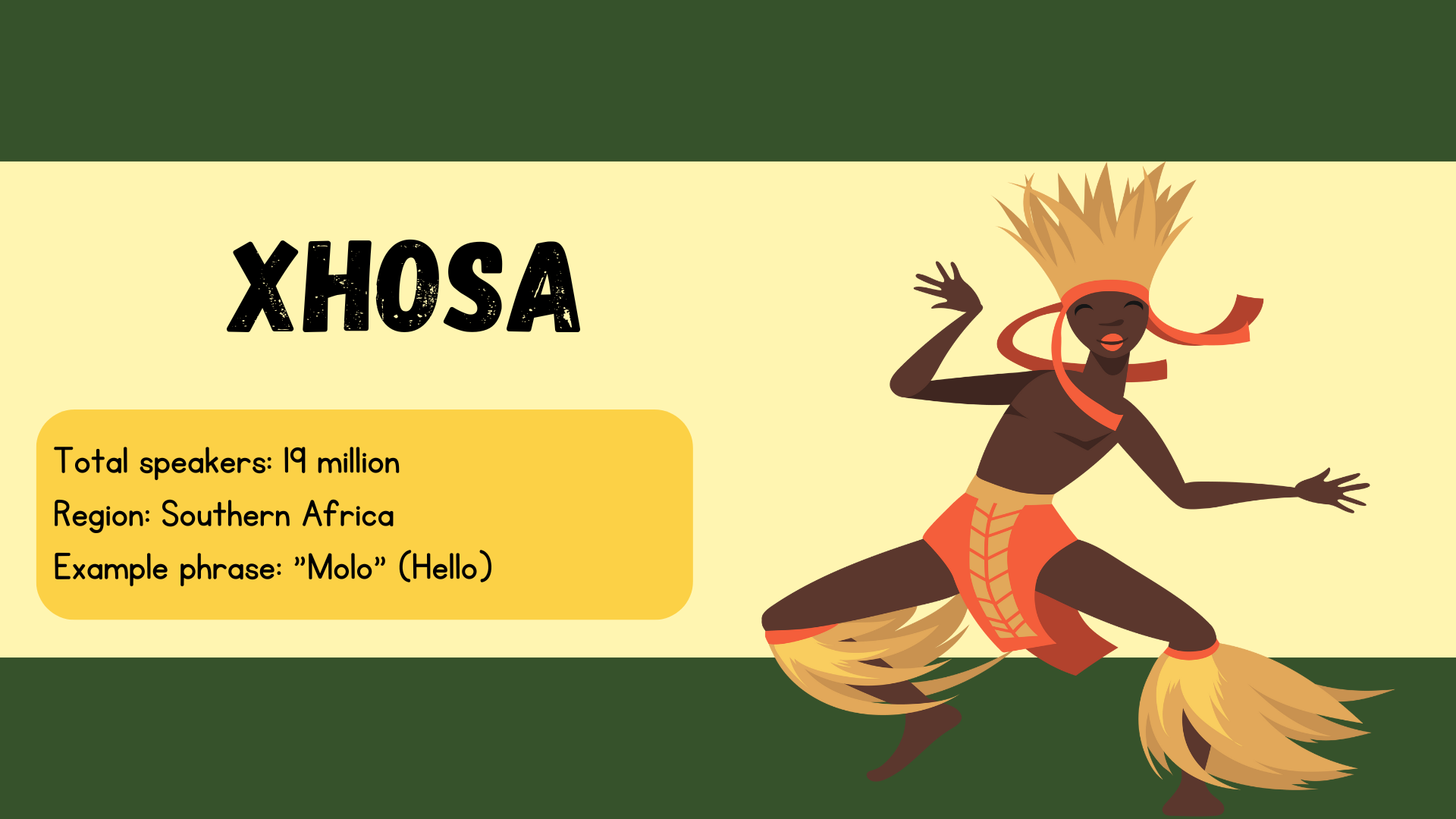
- Total speakers: 19 million
- Region: Southern Africa
- Example phrase: “Molo” (Hello)
Xhosa is a Bantu language spoken primarily in South Africa, where it is one of the 11 official languages. It is famous for its use of clicks, inherited from interactions with Khoisan speakers. The language has a long oral tradition, and many South African writers, including Nelson Mandela, have used it to express both political and cultural sentiments. Xhosa is essential to the heritage of the Xhosa people and is often used in music, literature, and traditional ceremonies.
Arabic (Sa’idi)
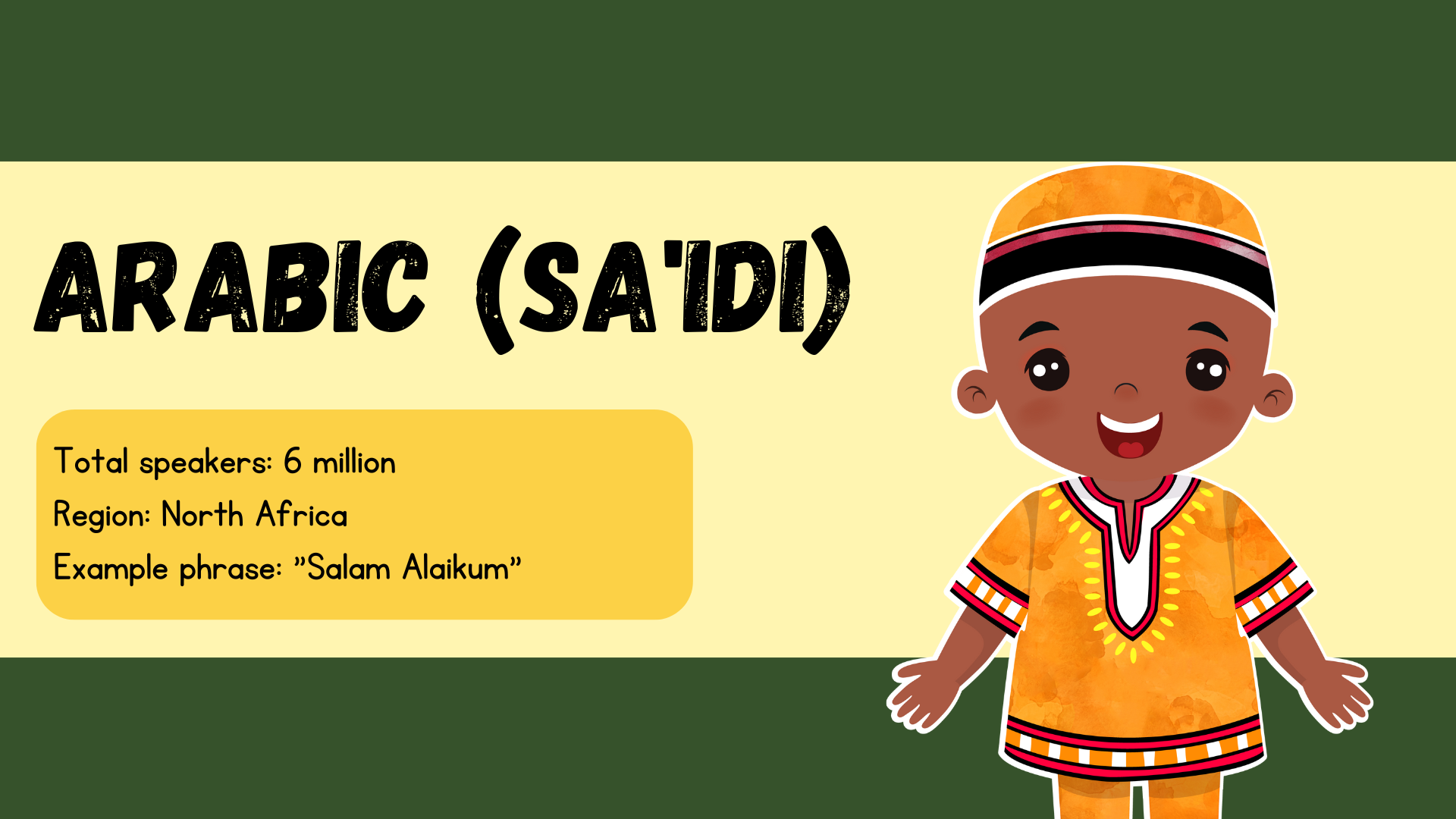
- Total speakers: 6 million
- Region: North Africa
- Example phrase: “Salam Alaikum” (Peace be upon you)
Sa’idi Arabic is a variety of Arabic spoken in the southern regions of Egypt. It differs from Egyptian Arabic due to its more conservative structure and vocabulary, retaining features closer to classical Arabic. Despite its regional nature, Sa’idi Arabic is an essential part of the culture of Upper Egypt, with its own rich folklore, poetry, and music.
Sesotho (Southern Sotho)
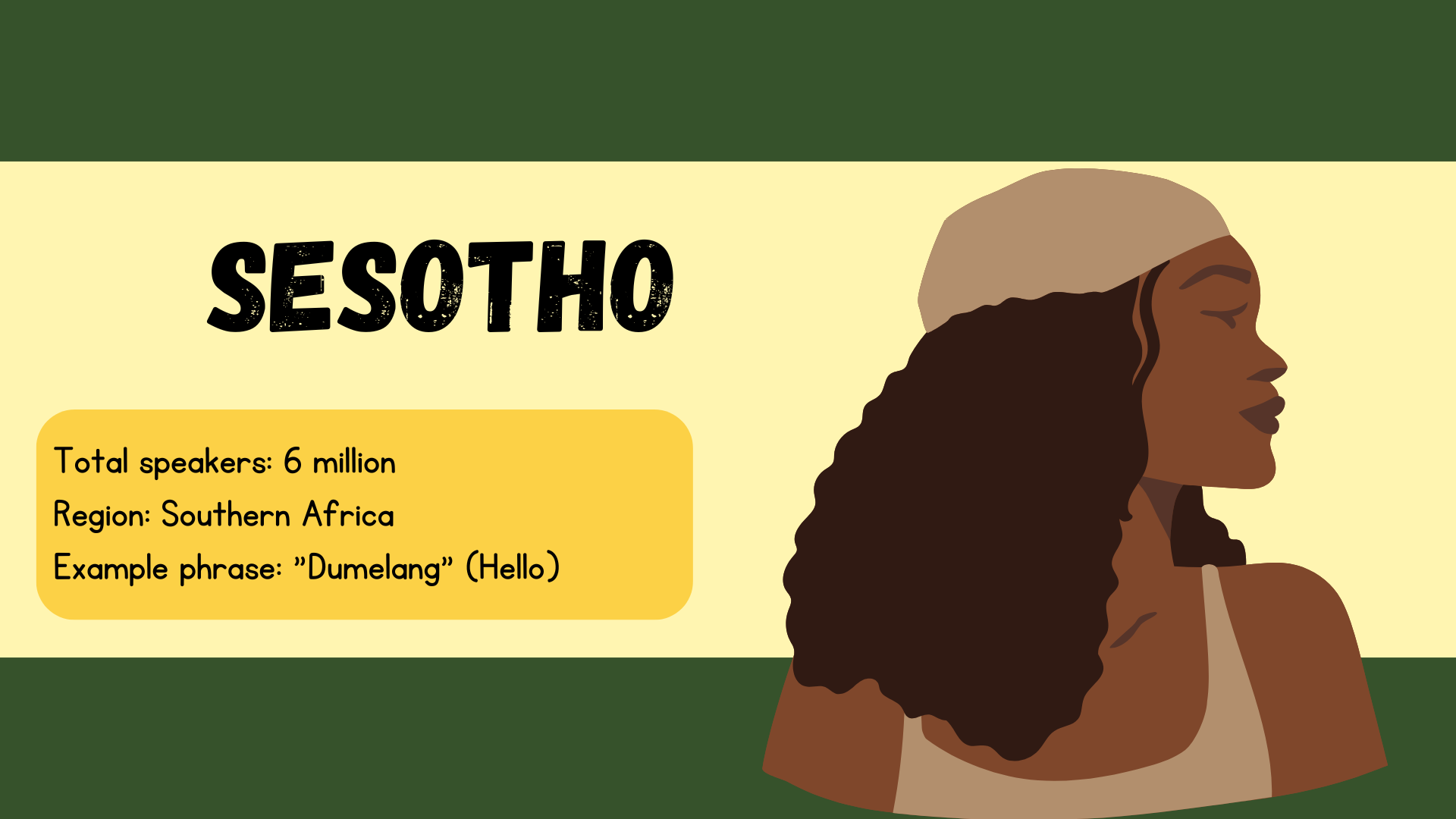
- Total speakers: 6 million
- Region: Southern Africa
- Example phrase: “Dumelang” (Hello)
Sesotho, also known as Southern Sotho, is spoken primarily in South Africa and Lesotho. It is one of the 11 official languages of South Africa and the official language of Lesotho. Sesotho is a Bantu language with a strong oral tradition, including stories, proverbs, and songs. The language plays an important cultural role in the daily life of Basotho people, and it is used in media, education, and governance.
Kongo
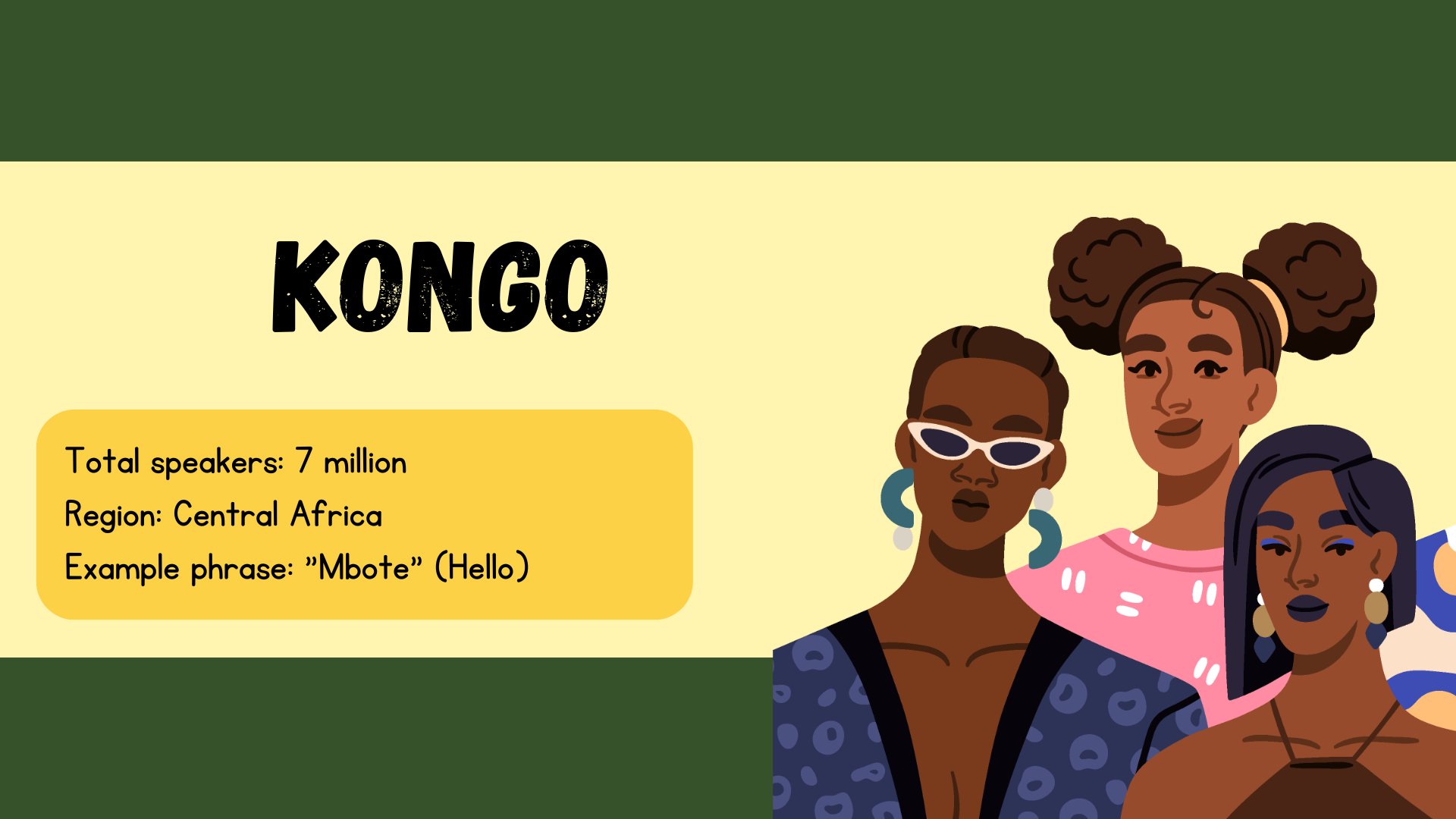
- Total speakers: 7 million
- Region: Central Africa
- Example phrase: “Mbote” (Hello)
Kongo is spoken by the Kongo people in the Republic of the Congo, the Democratic Republic of the Congo, and Angola. It is a Bantu language and has several dialects. Kongo has a rich tradition of oral literature, with storytelling and proverbs being key elements of the culture. It is also significant in the context of the slave trade, as Kongo-speaking people were dispersed across the Atlantic to the Americas.
Chichewa
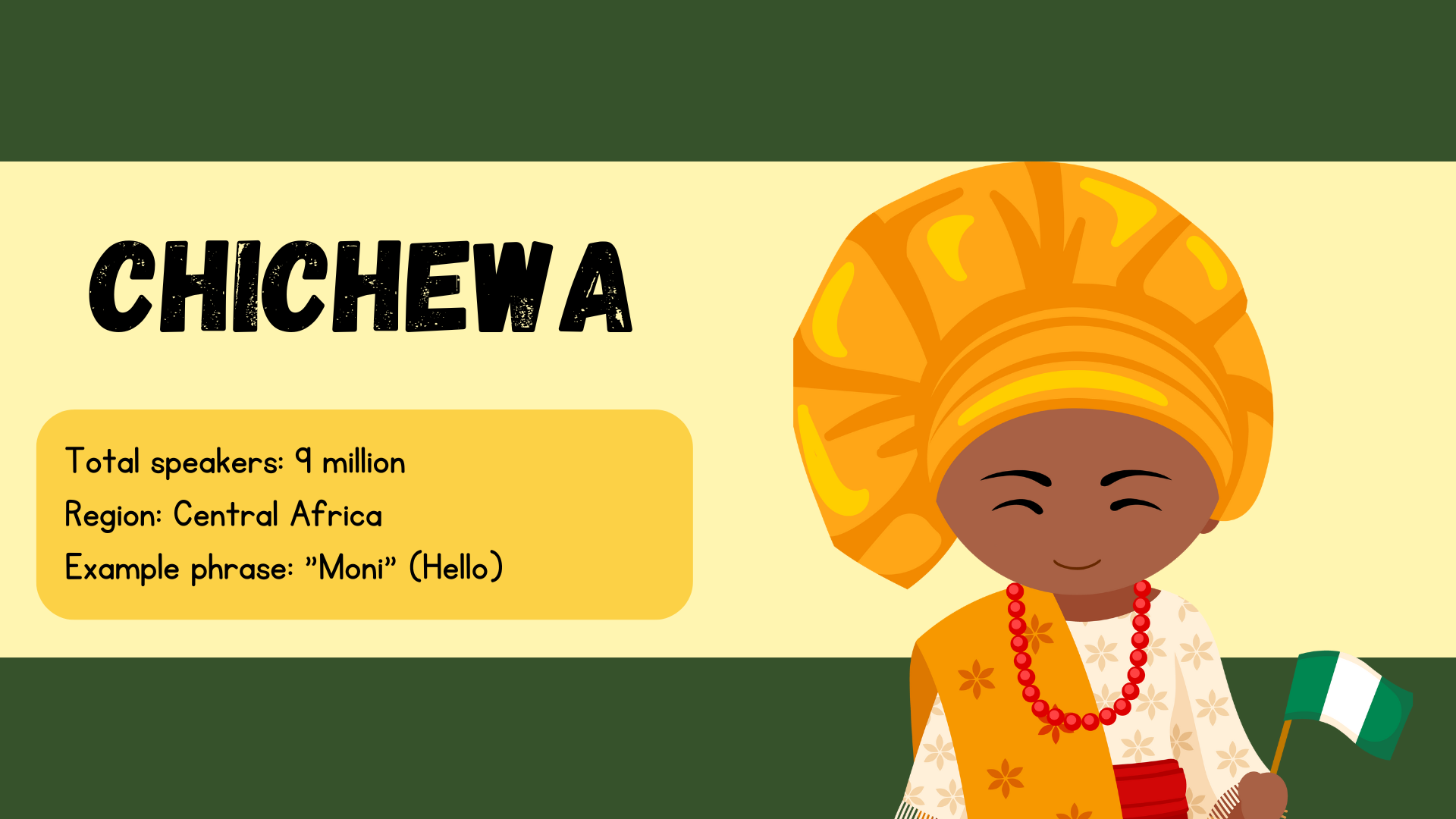
- Total speakers: 9 million
- Region: Central Africa
- Example phrase: “Moni” (Hello)
Chichewa, or Chewa, is spoken primarily in Malawi, Zambia, and Mozambique. It is the national language of Malawi and serves as a lingua franca in parts of Zambia. Chichewa is part of the Bantu family and has a significant oral tradition, with folktales, proverbs, and songs that carry cultural significance. The language is also used in education and media in Malawi.
Wolof
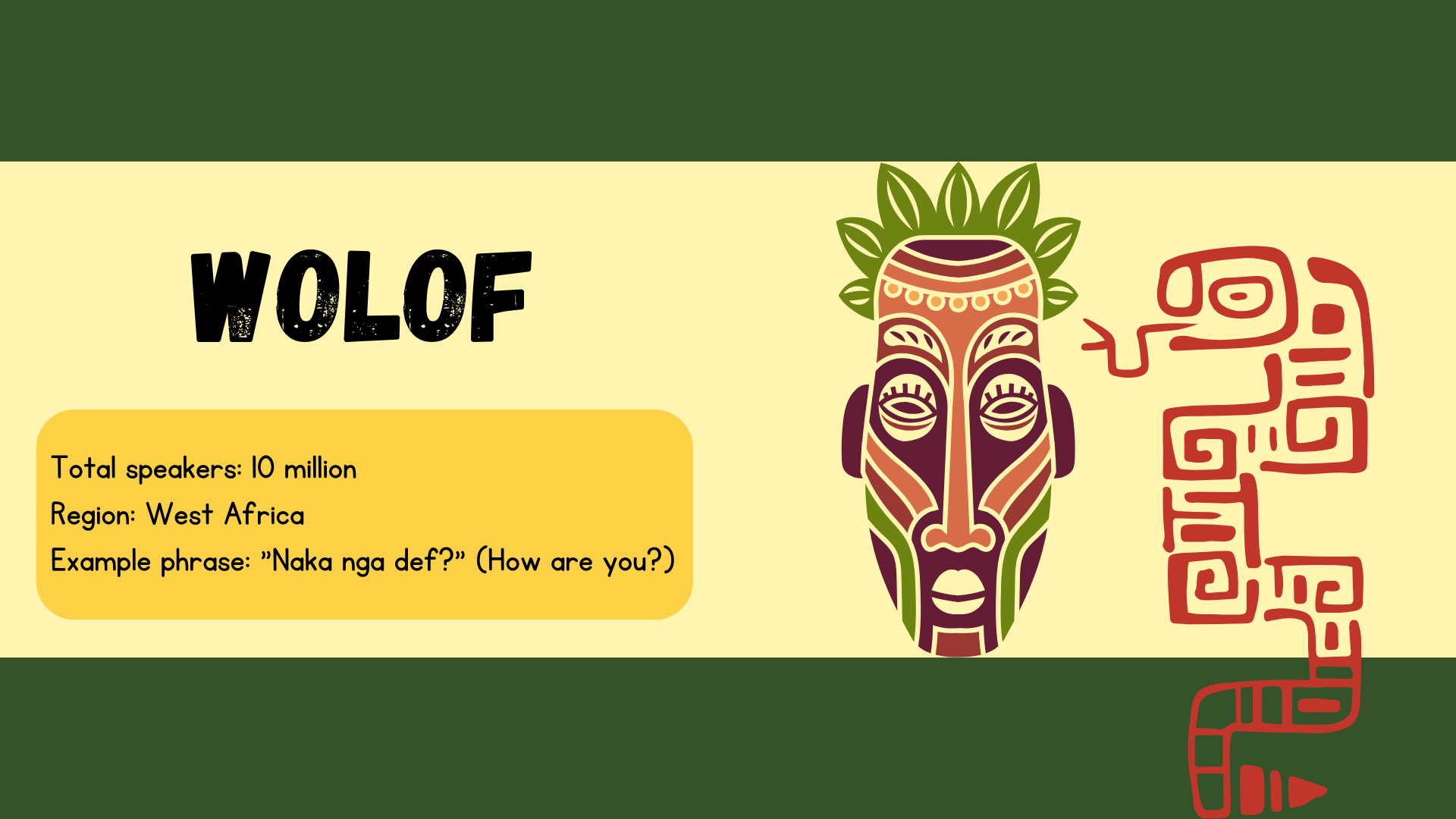
- Total speakers: 10 million
- Region: West Africa
- Example phrase: “Naka nga def?” (How are you?)
Wolof is widely spoken in Senegal, where it is the most prominent language, as well as in parts of Gambia and Mauritania. Wolof serves as the lingua franca in Senegal, uniting speakers of various native languages. The language is vital to Senegalese culture, influencing music (especially in the popular genre mbalax), art, and folklore. Wolof also plays a significant role in the Islamic community in West Africa.
Bemba
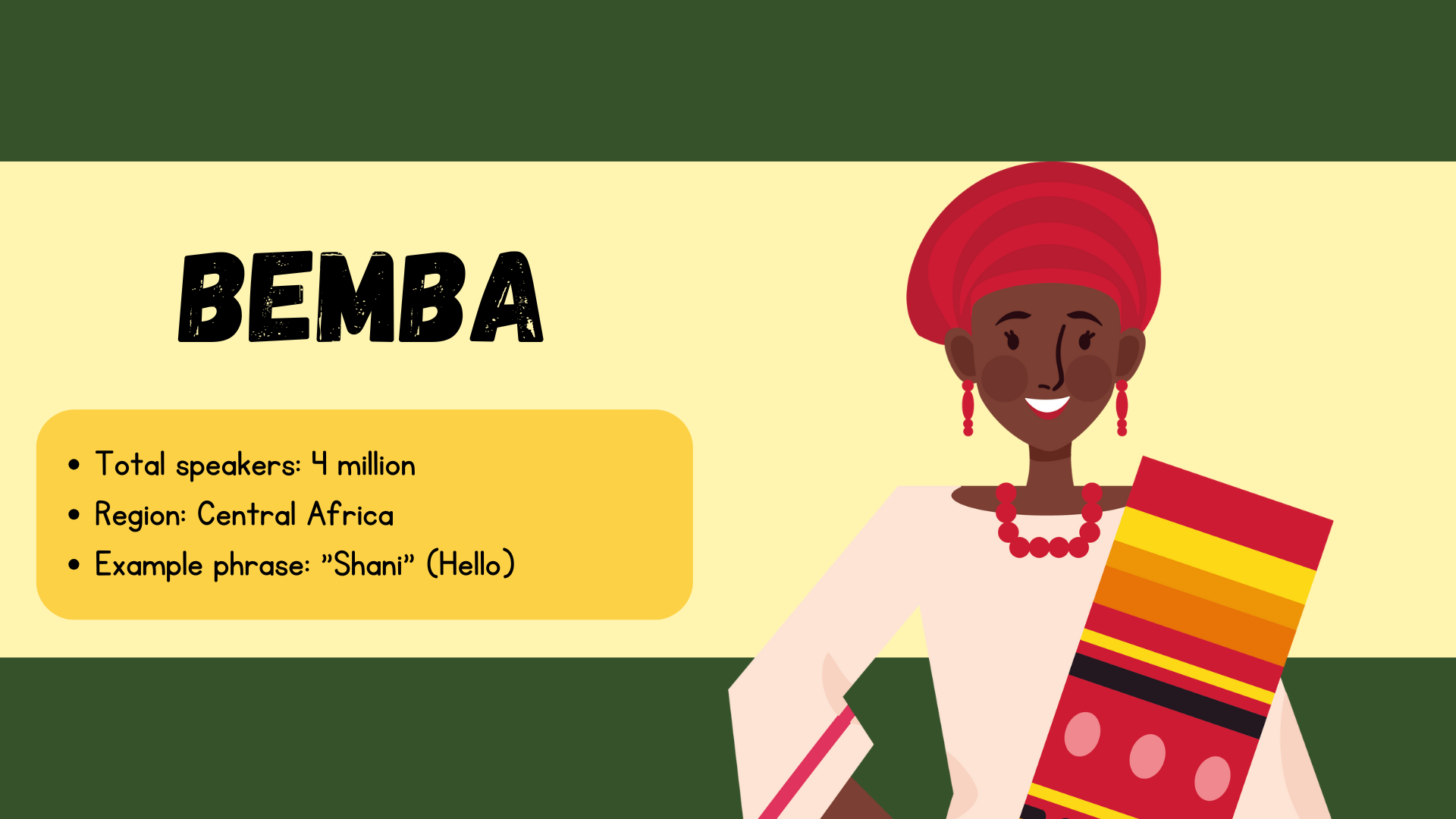
- Total speakers: 4 million
- Region: Central Africa
- Example phrase: “Shani” (Hello)
Bemba is a Bantu language spoken in Zambia and parts of the Democratic Republic of the Congo. It is one of Zambia’s most widely spoken languages and serves as a lingua franca in many regions. Bemba is used in media and education and is central to the cultural identity of the Bemba people, known for their traditions, proverbs, and oral storytelling.
Tswana
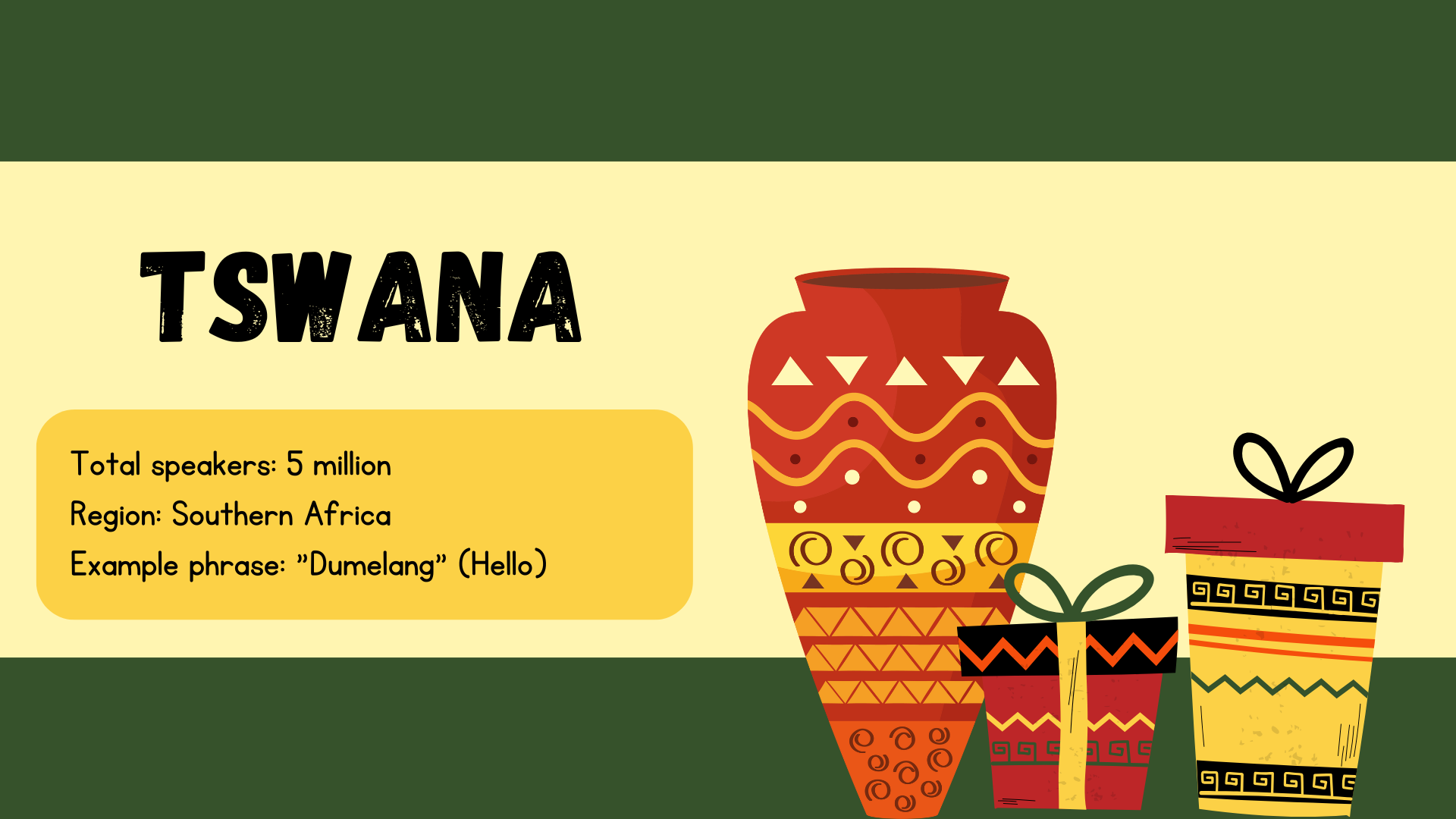
- Total speakers: 5 million
- Region: Southern Africa
- Example phrase: “Dumelang” (Hello)
Tswana, or Setswana, is spoken in Botswana and parts of South Africa, Namibia, and Zimbabwe. Tswana is a Bantu language and has a strong oral tradition. It is used in daily communication, education, and media. The Tswana people’s heritage is interwoven with the language, as it is central to their customs, songs, and folklore. The language also plays a key role in Botswana’s national identity.
Twi
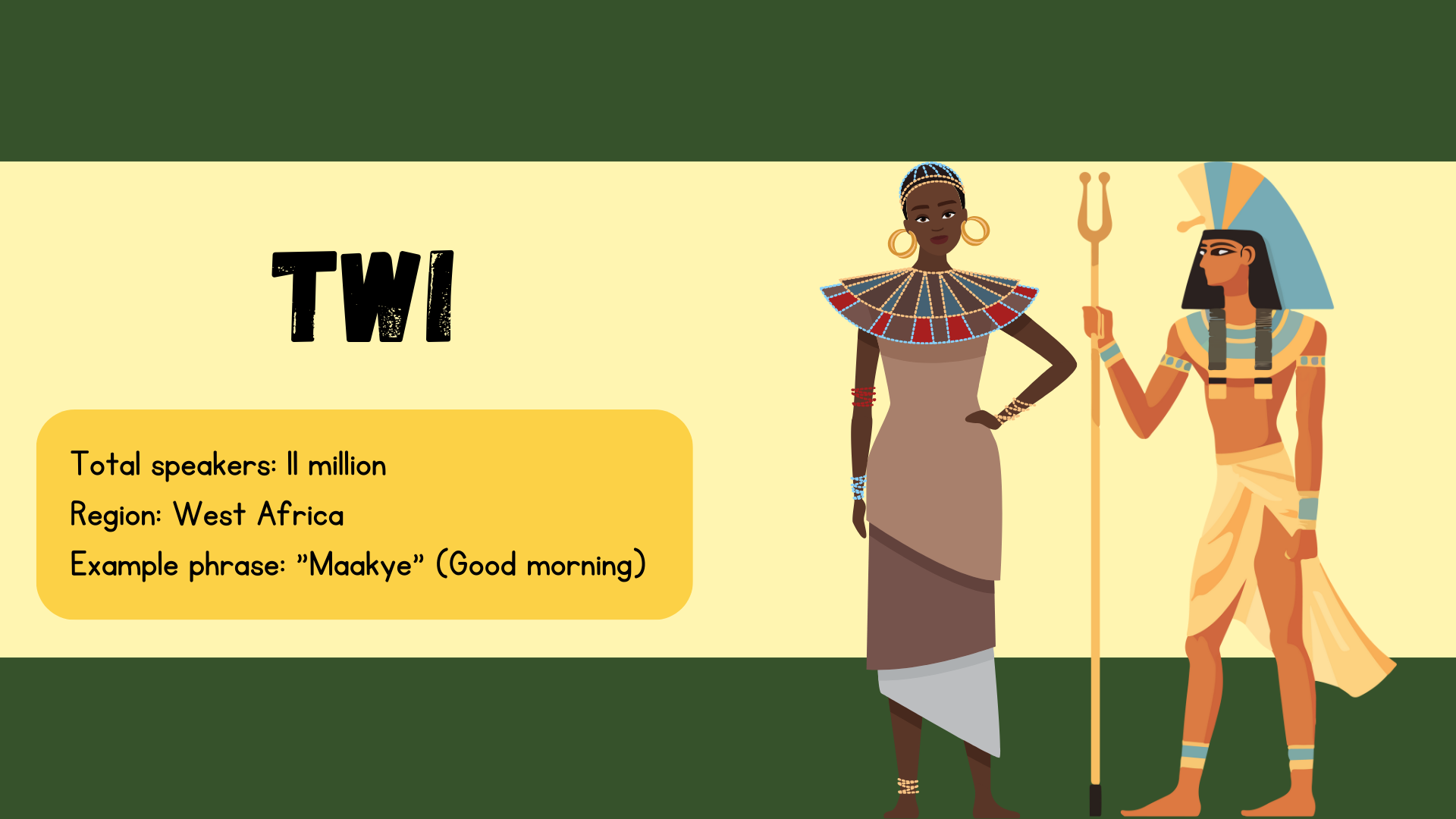
- Total speakers: 11 million
- Region: West Africa
- Example phrase: “Maakye” (Good morning)
Twi is a dialect of the Akan language spoken in Ghana, where it is one of the most widely used languages. Twi is part of the Niger-Congo family and has several dialects. It is important in the culture of the Ashanti people, with a rich tradition of proverbs, oral storytelling, and music. The language is used in everyday life, media, and education, and is essential to Ghanaian identity.
Tigrinya

- Total speakers: 9 million
- Region: East Africa
- Example phrase: “Selam” (Hello)
Tigrinya is spoken in Eritrea and northern Ethiopia, primarily by the Tigrinya people. It is a Semitic language that uses the Ge’ez script. The language has been central to the religious, cultural, and historical identity of these regions. Tigrinya speakers have a strong oral tradition, with poetry and songs being integral to their cultural heritage.
Venda
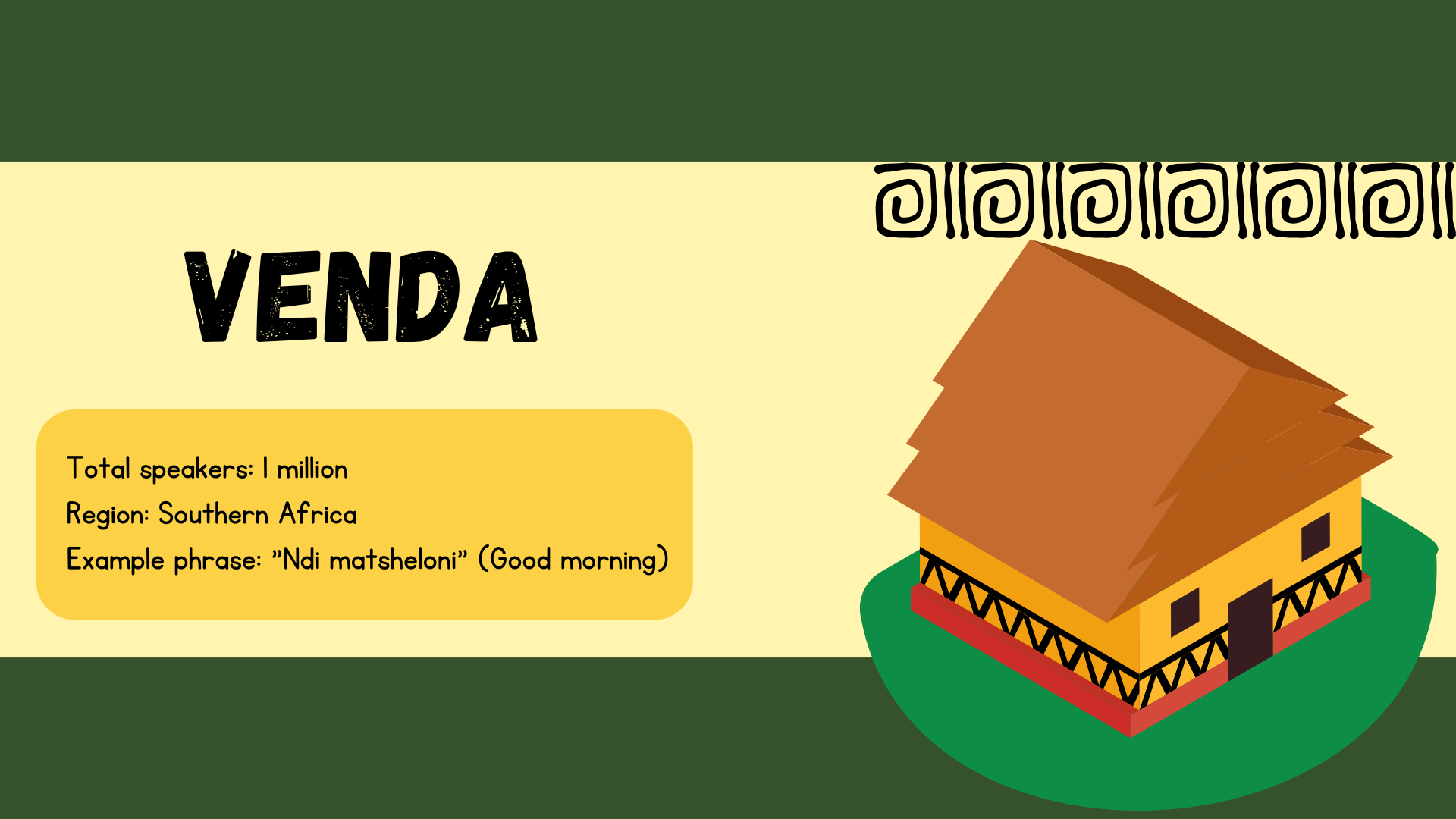
- Total speakers: 1 million
- Region: Southern Africa
- Example phrase: “Ndi matsheloni” (Good morning)
Venda is spoken by the Venda people in the Limpopo province of South Africa and in parts of Zimbabwe. It is one of South Africa’s official languages and has a rich tradition of oral literature, particularly in the form of folktales and myths. The language also plays a role in the traditional music and dance of the Venda people, contributing to the region’s cultural heritage.
Ndebele
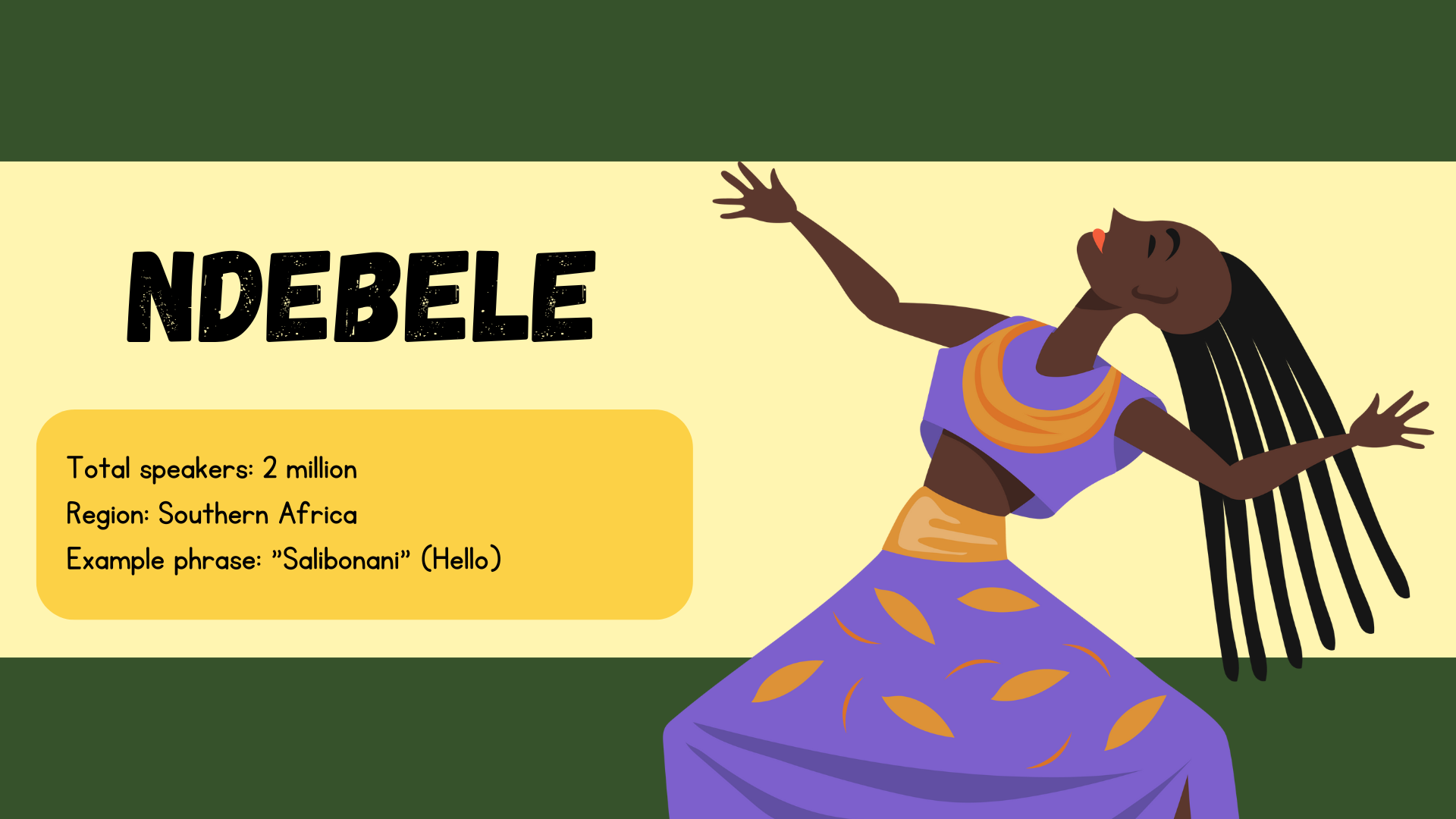
- Total speakers: 2 million
- Region: Southern Africa
- Example phrase: “Salibonani” (Hello)
Ndebele is spoken by the Ndebele people in Zimbabwe and South Africa. It is a Nguni language, closely related to Zulu and Xhosa, and is known for its vibrant art and cultural traditions, which often involve bright, geometric designs and elaborate beadwork. Ndebele has a strong oral literature tradition, and its speakers use the language in cultural events, traditional ceremonies, and daily communication.
Fula (Fulani)
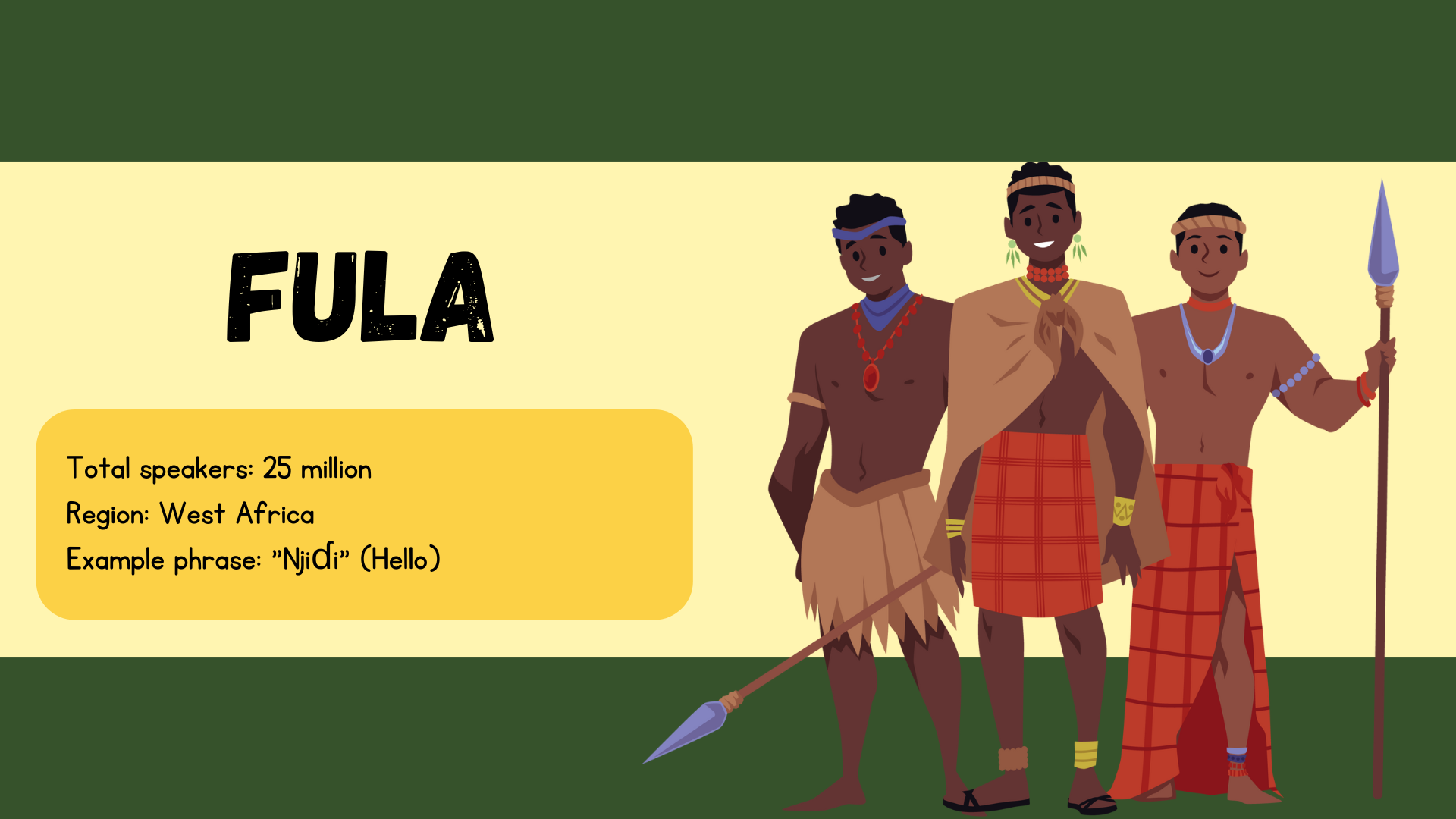
- Total speakers: 25 million
- Region: West Africa
- Example phrase: “Njiɗi” (Hello)
Fula, also known as Fulani, is spoken across a large part of West and Central Africa. The Fula people are one of the largest ethnic groups in the region, and the language has many dialects. Fula is widely used in trade, cultural expression, and communication across national borders, making it a key language for regional identity. Its speakers are often associated with pastoralism, and the language’s rich oral tradition includes epic poetry and proverbs.
Arabic (Moroccan)
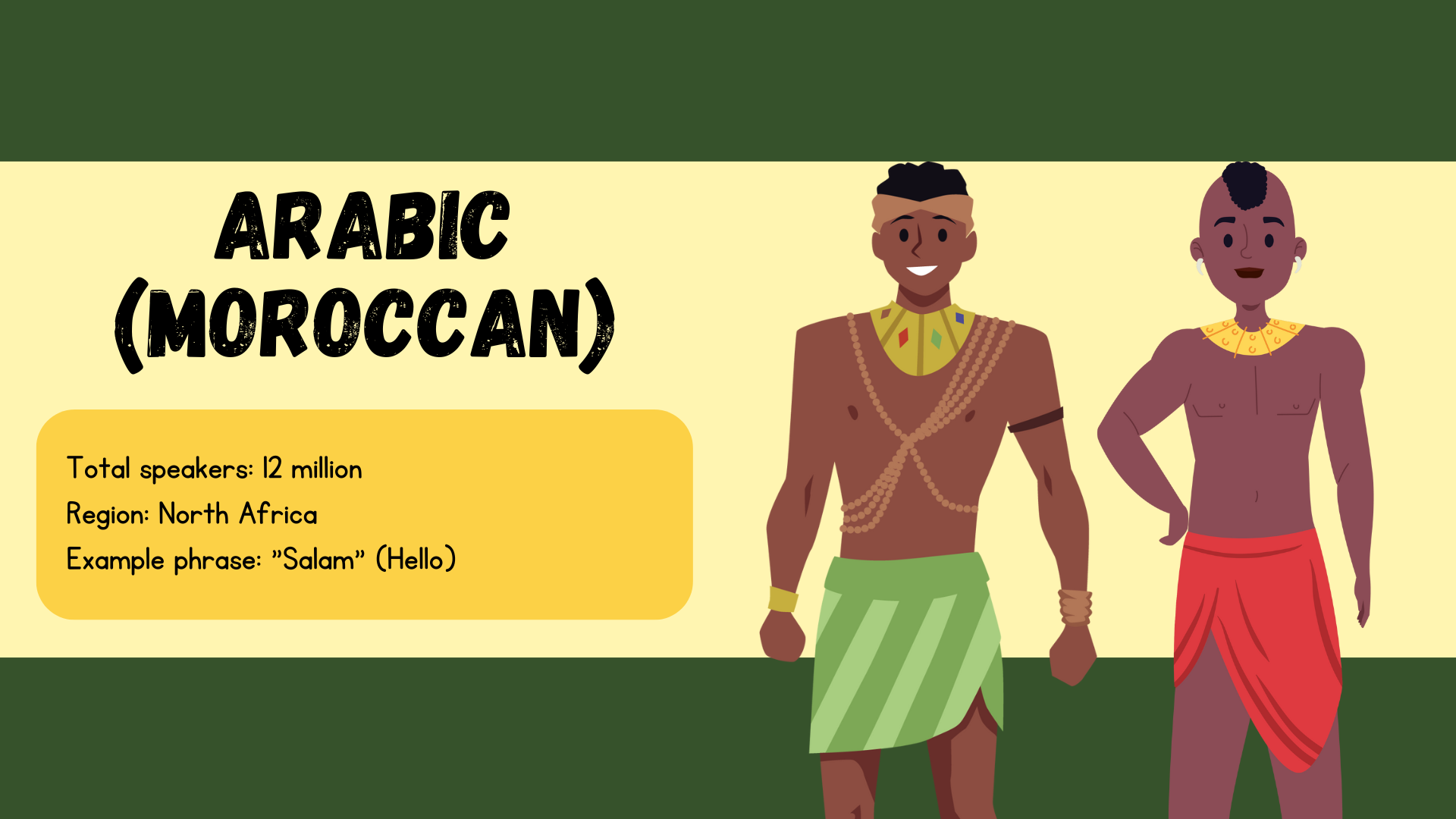
- Total speakers: 12 million
- Region: North Africa
- Example phrase: “Salam” (Hello)
Moroccan Arabic, or Darija, is the variety of Arabic spoken in Morocco. While it is derived from Classical Arabic, it has many influences from Berber, French, and Spanish. Darija is the primary language of daily communication, while Modern Standard Arabic is used in formal settings. The language is rich in slang and local expressions and serves as a marker of Moroccan identity in a multilingual society.
Also Read: What Languages Are Spoken In India? An Ultimate Guide
Challenges Facing African Languages
Language preservation
Many African languages are disappearing because of global influences, urban living, and the impact of colonial languages. As young people move to cities and start using languages like English or French to get ahead, local languages are used less at home and in communities.
In schools across many African countries, the focus is often on colonial languages such as English and French. Indigenous languages are mostly left for informal talks or cultural events. This approach in schools makes it hard for these languages to be passed down to the next generation, putting them at risk of vanishing.
Modernization and globalization impacts
Modernization and globalization are making it tough to keep African languages alive. As countries grow and join the global market, big languages like English, French, and Arabic are pushing local languages aside. You can see this happening in schools and the media where these international languages are often chosen because they’re useful worldwide.
At the same time, more people are moving to cities. This mix of different language speakers in one place means that many end up speaking the more common languages to get by in everyday life. If we don’t actively work to keep these local languages alive, they might lose their spark and importance. This would be a big loss because the variety of languages in Africa is a big part of what makes the continent unique.
Conclusion
Africa’s top 35 languages show how diverse the continent is. These languages are more than just ways to talk every day; they carry the deep cultural histories and identities of African communities. Sure, they face challenges like globalization and some languages are at risk of disappearing. But these languages are crucial. They help keep Africa’s unique cultural heritage alive and celebrated. Keep visiting the Translation Blog for more interesting translation articles.

